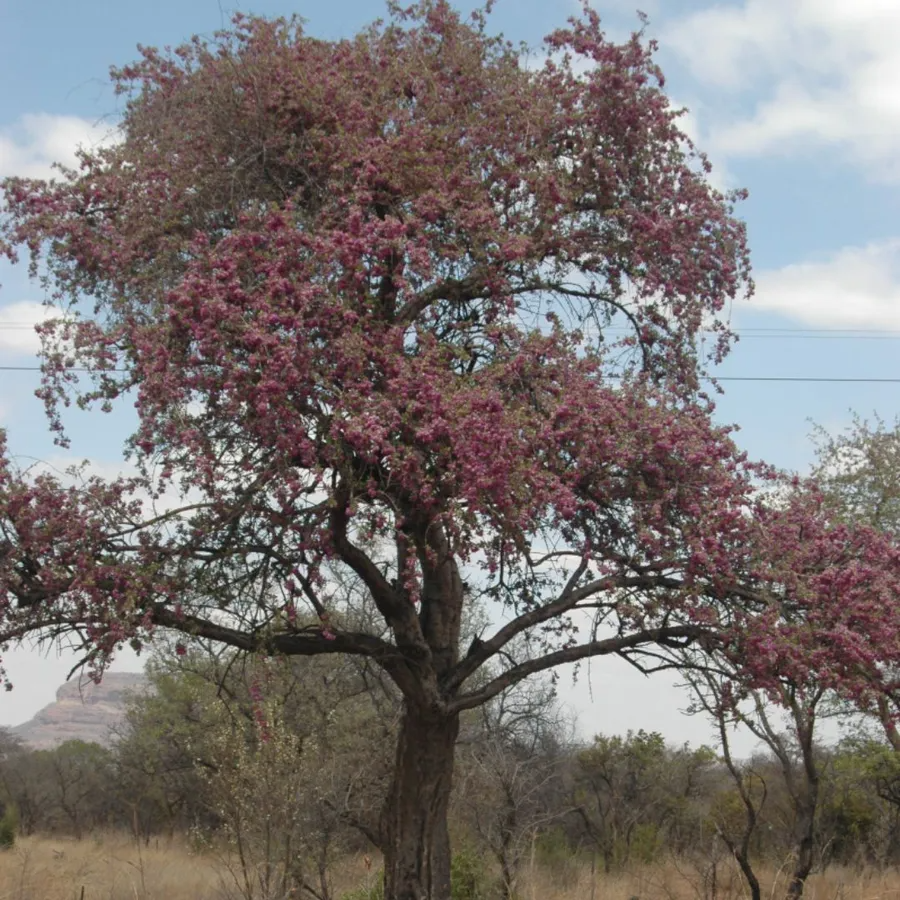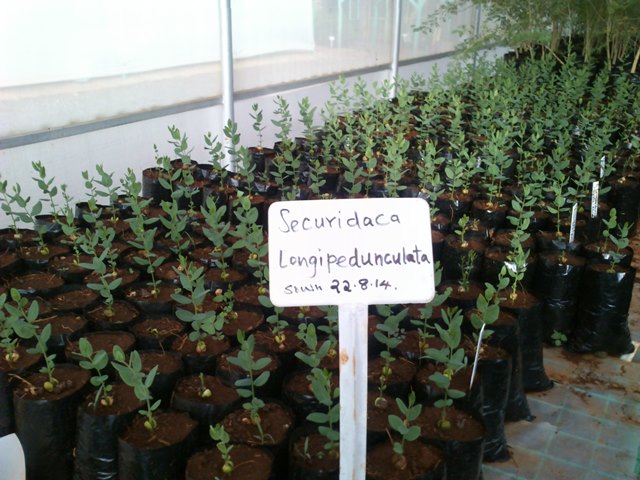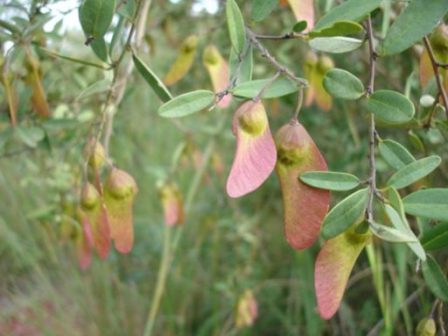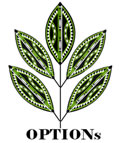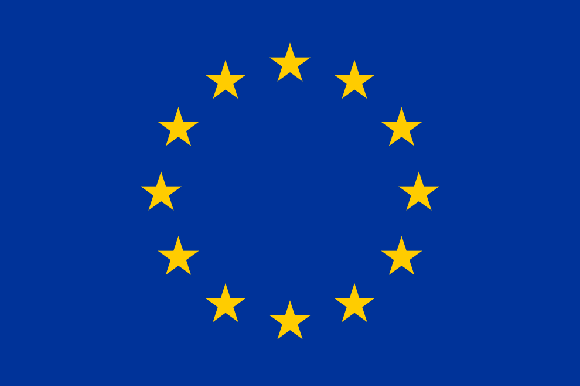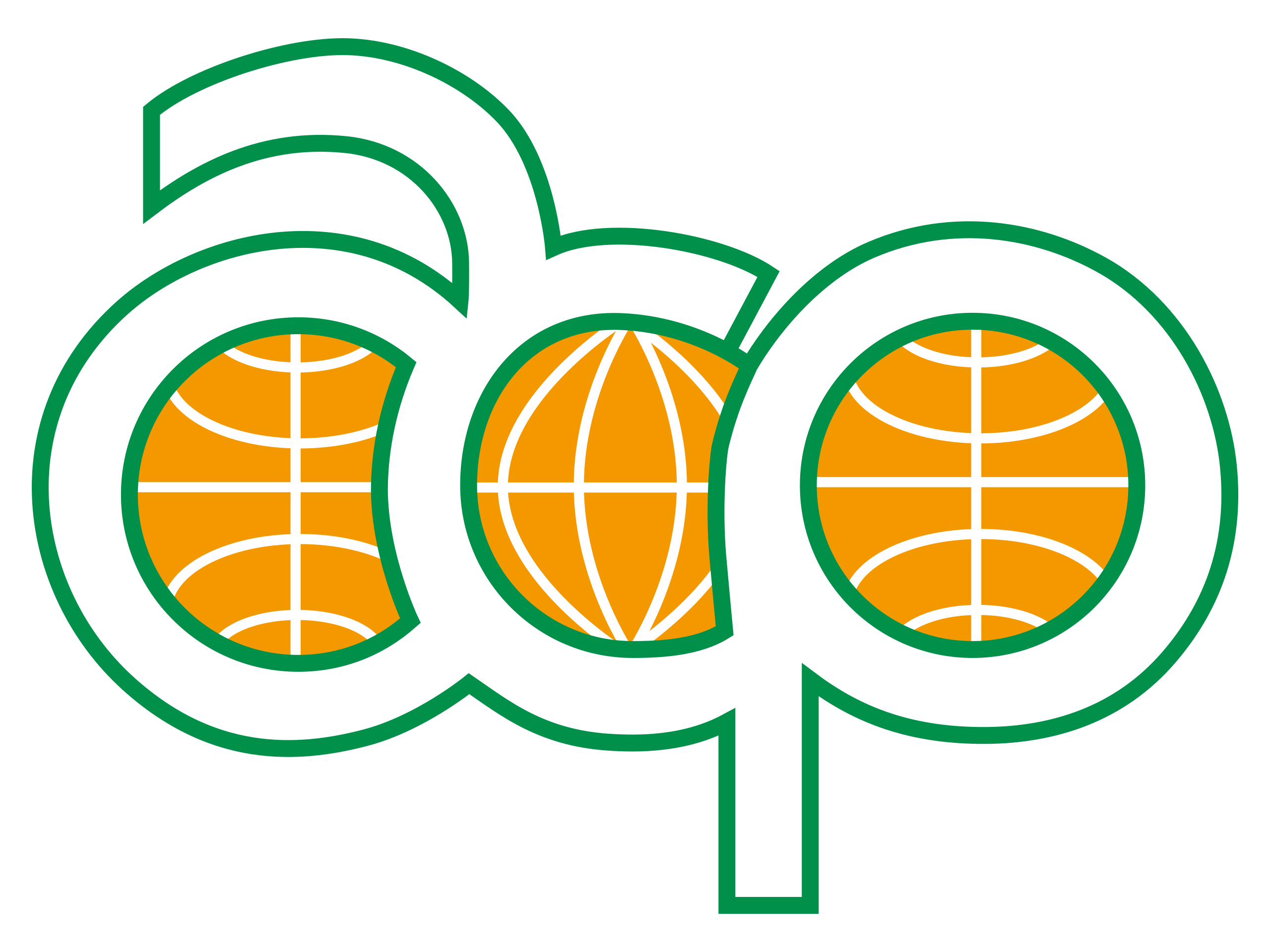OPTIONs is a project funded by the European Union's EuropeAid Department and the European Development Fund.
The funding is implemented by the Africa, Caribbean and Pacific (ACP) Science and Technology Programme
Popular press articles
A training workshop with more than 60 farmers from Western Kenya took place at the National Museums of Kenya over the 25th and 26th May. Training was provided on how to use pesticidal plants, giving farmers practical hands-on experience in making their own extracts. The event was broadcast on Kenyan national news by TV channel KBC as well as in several newspapers.
A new leaflet published by the Alliance for Food Sovereignty in Africa provides practical advice on Using Pesticidal Plants for Pest Management in Africa. And in French.
New leaflet highlighting OPTIONs activities and partners in Kenya: OPTIONs partnership encourages farmers to grow and use natural pesticidal plants, rather than synthetic chemicals for pest control
Article appearing on the ENSIA web magazine, Could traditional plants hold the secret to saving crops from pests? Researchers build on age-old practices to reduce food loss in Africa.
OPTIONs pesticidal tree planting initiative is profiled in a newsletter from Sustainable Global Gardens
An article about the OPTIONs project is published in The Ismaili Magazine: Pesticidal plants to protect crops and grains
CIFOR's Forest News highlights OPTIONs work on understanding policy issues: In fight against African pests, researchers point to natural-born killers
The ACP S&T leaflet about OPTIONs
Training materials
A practical handbook for farmers and experts is produced, giving information on best practices on the use of pesticidal plants. The Handbook on Pesticidal Plants can be downloaded from here.
Anjarwalla P, Belmain S, Sola P, Jamnadass R, Stevenson PC. 2016. Handbook on Pesticidal Plants. World Agroforestry Centre (ICRAF), Nairobi, Kenya
The Handbook on Pesticidal Plants is also available in French, which can be downloaded from here
The National Museums of Kenya team at the East Africa Herbarium leaflet on the propagation of Securidaca longepedunculata, one of the target indigenous, slow-growing, recalcitrant species of the OPTIONs project.
Proceedings of a training workshop on Optimisation of Pesticidal plants: Technology Innovation, Outreach & Networks (OPTIONs). The workshop was held at the World Agroforestry Centre, Nairobi, Kenya, 28-30 October 2014. Presentations from this workshop on growing and using pesticidal plants are found below.
Pesticidal plants, an alternative to synthetic chemicals
Sustainable harvesting of pesticidal plants
Status and availability of germplasm of pesticidal plants
Making quality seed collections
Principles of propagation and cultivation of pesticidal plants
Using pesticidal plants for crop protection
Potential for small scale marketing of pesticidal plants
Current status of pyrethrum sector in Kenya
Overview of the organic agriculture sector in Kenya
Fact sheets have been created in collaboration with the World Agroforestry Centre and the Royal Botanic Gardens Kew. More information about these pesticidal species can be found on the Plant Database pages as well through ICRAF's species switchboard
Fact sheet about Aloe ferox
Fact sheet about Chenopodium (syn. Dysphania) ambrosioides
Fact sheet about Euphorbia tirucalli
Fact sheet about Lippia javanica
Fact sheet about Securidaca longepedunculata
Fact sheet about Solanum incanum
Fact sheet about Strychnos spinosa and in Kiswahili
Fact sheet about Tagetes minuta and in Kiswahili
Fact sheet about Tephrosia vogelii and in Kiswahili
Fact sheet about Tithonia diversifolia
Fact sheet about Vernonia amygdalina
Fact sheet about Zanthoxylum holtzianum
Guidelines for the Sustainable Harvesting of Traditional Medicinal Plants - but just as relevant for harvesting pesticidal plants
Anjarwalla P., Ofori D.A., Jamnadass R., Mowo J.G. & Stevenson P.C.(2013). Proceedings of a training workshop on sustainable production, harvesting and conservation of botanical pesticides. World Agroforestry Centre (ICRAF), Nairobi, Kenya. 61pp.
Scientific publications produced with OPTIONs support
Stevenson, P. C. and Belmain, S. R. (2016). Pesticidal plants in African agriculture: Local uses and global perspectives. Outlooks on Pest Management. 27(5): 226-230. (full text pdf)
Arnold, S. E. J., Stevenson, P. C., and Belmain, S. R. (2016). Shades of yellow: interactive effects of visual and odour cues in a pest beetle. PeerJ. 4:e2219 (full text pdf)
Stevenson, P.C., Green, P.W.C., Veitch, N.C., Farrell, I., Kusolwa, P. Belmain, S.R., (2016) Nor-Hopanes explain pest control activity of Zanha africana root bark. Phytochemistry, 123, 25-32. (full text pdf)
Nyahangare, E.T., Mvumi, B.M. and Maramba, T. (2016) Acute Oral Mammalian Toxicity and Effect of Solvents on Efficacy of Maerua edulis (Gilg. & Ben.) De Wolf against Rhipicephalus (Boophilus) decoloratus Koch, 1844 (Acarina: Ixodidae), Tick Larvae. BioMed Research International. 8. (full text pdf)
Mkenda, P., Mwanauta, R., Stevenson, P. C., Ndakidemi, P., Mtei, K., and Belmain, S. R. (2015). Extracts from field margin weeds provide economically viable and environmentally benign pest control compared to synthetic pesticides. Plos ONE. 10(11), e0143530. (full text pdf)
Arnold, S. E. J., Stevenson, P. C., and Belmain, S. R. (2015). Responses to colour and host odour cues in three cereal pest species, in the context of ecology and control. Bulletin of Entomological Research, 1–9. (full text pdf)
Mkenda, P.A. Stevenson, P.C. Ndakidemi, P., Farman, D.I. and Belmain, S.R. (2015) Contact and fumigant toxicity of five pesticidal plants against Callosobruchus maculatus (Coleoptera: Chrysomelidae) in stored cowpea (Vigna unguiculata). International Journal of Tropical Insect Science. 35(4): 172-184. (full text pdf)
Sola, P. Mvumi, B. M., Belmain, S.R., Ogendo, J. O., Mponda, O., Kamanula, J.F., Nyirenda, S. P. and Stevenson, P.C., (2014) Botanical pesticide production, trade and regulatory mechanisms in sub-Saharan Africa: making a case for plant-based pesticidal products. Food Security. 6(3): 369-384. (full text pdf)
Scientific journal articles - selected from OPTIONs project partners
Stevenson, P.C., Arnold, S.E.J. and Belmain, S.R. (2014) Pesticidal Plants for Stored Product Pests on Small-holder Farms in Africa In: Advances in Plant Biopesticides (ed. Dwijendra Singh), Springer India, pp. 149-172. (full text pdf)
Grzywacz, D., Stevenson, P.C., Mushobozi, W.L., Belmain, S. and Wilson, K. (2014) The use of indigenous ecological resources for pest control in Africa. Food Security, 6 (1). pp. 71-86. (full text pdf)
Amoabeng, B. W., Gurr, G. M. Gitau, C. W., Stevenson, P. C. (2014). Cost: benefit analysis of botanical insecticide use in cabbage: implications for smallholder farmers in developing countries. Crop Protection. 57, 71-76. (full text pdf)
Isman, M.B. and Grieneise, M.L. (2014) Botanical insecticide research: many publications, limited useful data. Trends in Plant Science. 19(3): 140 – 145. (full text pdf)
Amoabeng, B.W., Gurr, G.M., Gitau, C.W., Nicol, H.I., Munyakazi, L. and Stevenson, P.C. (2013) Tri-Trophic Insecticidal Effects of African Plants against Cabbage Pests. PloS One, 8 (10) p. e78651 (full text pdf)
Ogendo, J.O., Lukhoba, C.W., Bett, P.K. and Machocho, A.K. (Eds.) (2013) Proceedings of The First International Conference on Pesticidal Plants. Egerton University, Kenya. 275 pp. (full text pdf)
Belmain, S.R., Haggar, J., Holt, J. and Stevenson, P.C. (2013). Managing legume pests in sub-Saharan Africa: Challenges and prospects for improving food security and nutrition through agro-ecological intensification. Chatham Maritime (United Kingdom): Natural Resources Institute, University of Greenwich. 34p. (full text pdf)
Madzimure, J., Nyahangare, E.T., Hamudikuwanda, H., Hove, T., Belmain, S.R. Stevenson, P.C. and Mvumi, B.M. (2013) Efficacy of Strychnos spinosa (Lam.) and Solanum incanum L. aqueous fruit extracts against cattle ticks. Tropical Animal Health and Production . (full text pdf)
Arnold, S.E.J, Stevenson, P.C. and Belmain, S.R. (2012) Odour-mediated orientation of beetles is influenced by age, sex and morph. PLoS ONE. 7(11): e49071 (full text pdf)
Belmain, S.R., Amoah, B.A., Nyirenda, S.P., Kamanula, J.F. and Stevenson, P.C. (2012) Highly variable insect control efficacy of Tephrosia vogelii chemotypes. Journal of Agricultural and Food Chemistry. 60(40): 10055–10063. (full text pdf)
Stevenson, P. C. Nyirenda, S.P., Mvumi, B.M., Sola, P., Kamanula, J.F., Sileshi, G., Belmain, S.R. (2012) Pesticidal plants: A viable alternative insect pest management approach for resource-poor farming in Africa. In: Opender Koul, G. S. Dhaliwal, S. Khokhar and Ram Singh (eds.), Biopesticides in Environment and Food Security: Issues and Strategies, Scientific Publishers, Jodhpur, India, pp. 212-238. (full text pdf)
Nyahangare, E.T., Hove, T., Mvumi, B.M., Hamudikuwanda, H., Belmain, S.R., Madzimure, J. and Stevenson, P.C. (2012) Acute mammalian toxicity of four pesticidal plants.Journal of Medicinal Plants Research. 6 (13): 2674-2680. (full text pdf)
Muzemu, S., Mvumi, B.M., Nyirenda, S.P.N. Sileshi, G.W., Sola, P., Kamanula, J.F., Belmain, S.R. and Stevenson, P.C. (2012) Pesticidal effects of indigenous plants extracts against rape aphids and tomato red spider mites. African Crop Science Conference Proceedings. 10: 169 - 171. (full text pdf)
Chikukura, L., Mvumi, B.M., Chikonzo, R. and Chenzara, C. (2012) Evaluation of selected indigenous pesticidal plant powders against stored maize and cowpeas insect pests African Crop Science Conference Proceedings. 10: 189 - 192. (full text pdf)
Philip C. Stevenson, Geoffrey C. Kite, Gwilym P. Lewis, Félix Forest, Stephen P. Nyirenda, Steven R. Belmain, Gudeta W. Sileshi, Nigel C. Veitch (2012). Distinct chemotypes of Tephrosia vogelii and implications for their use in pest control and soil enrichment. Phytochemistry. 78: 135-146. (full text pdf)
Thokozani, B.L.K, Zulu, D., Sileshi, G.W., Teklehaimanot, Z., Gondwe, D.S.B., Sarasan, V. and Stevenson, P.C. (2011). Seed germination and in vitro regeneration of the African medicinal and pesticidal plant, Bobgunnia Madagascariensis. African Journal of Biotechnology. 10(32): 5959-5966 (full text pdf)
Zulu, D., Thokozani, B.L.K., Sileshi, G.W., Teklehaimanot, Z., Gondwe, D.S.B., Sarasan, V. and Stevenson, P.C. (2011). Propagation of the African medicinal and pesticidal plant, Securidaca longepedunculata. African Journal of Biotechnology. 10(32): 5988-5992. (full text pdf)
Sarasan, V., Kite, G., Sileshi, G. & Stevenson, P. (2011). Applications of phytochemical and in vitro techniques for erating income for the rural poor. Plant Cell Reports. 30(7):1163-1172. (full text pdf)
Nyirenda, S.P.N. Sileshi, G., Belmain, S.R., Kamanula, J.F., Mvumi, B., Sola, P., Nyirenda, G.K.C. & Stevenson, P.C. (2011). Farmers’ ethno-ecological knowledge of vegetable pests and pesticidal plant use in northern Malawi and eastern Zambia. African Journal of Agricultural Research. (full text pdf)
Kamanula J., Sileshi, G.W., Belmain, S.R., Sola, P., Mvumi, B.M., Nyirenda, G.K.C., Nyirenda, S.P.N. & Stevenson, P.C. (2011) Farmers’ Insect Pest management practices and pesticidal plant use for protection of stored maize and beans in Southern Africa. International Journal of Pest Management. 57(1): 41-49. (full text pdf)
Madzimure, J., Nyahangare, E.T., Hamudikuwanda, H., Hove, T., Stevenson, P.C., Belmain, S.R., and Mvumi, B.M. (2011) Acaricidal efficacy against cattle ticks and acute oral toxicity of Lippia javanica (Burm F.) Spreng. Tropical Animal Health and Production. 43:481–489. (full text pdf)
Stevenson, P.C., Nyirenda, S.P., Veitch, N.C. (2010). Highly glycosylated flavonoids from the pods of Bobgunnia madagascariensis. Tetrahedron Letters. 51: 4727–4730. (full text pdf)
Stevenson, P.C., Dayarathna, T.K., Belmain, S.R. and Veitch, N.C. (2009). Bisdesmosidic saponins from Securidaca longepedunculata roots: Evaluation of deterrency and toxicity to coleopteran storage pests. Journal of Agricultural and Food Chemistry. 57: 8860–8867. (full text pdf)
Koul, O. and Walia, S. (2009). Comparing impacts of plant extracts and pure allelochemicals and implications for pest control. CAB Reviews: Perspectives in Agriculture, Veterinary Science, Nutrition and Natural Resources 4 (49):1-30. (full text pdf)
Isman, M. (2008). Botanical insecticides: for richer, for poorer. Pest Management Science. 64: 8–11. (full text pdf)
Koul, O. (2008). Phytochemicals and Insect Control: An Antifeedant Approach. Critical Reviews in Plant Sciences. 27:1, 1-24. (full text pdf)
Akhtar, Y., Yeoung, Y.R. & Isman, M.B. (2008). Comparative bioactivity of selected extracts from Meliaceae and some commercial botanical insecticides against two noctuid caterpillars, Trichoplusia ni and Pseudaletia unipuncta. Phytochemical Review. 7:77–88. (full text pdf)
Koul, O., Walia, S. and Dhaliwal, G.S. (2008). Essential Oils as Green Pesticides: Potential and Constraints. Biopesticides International. 4(1): 63–84. (full text pdf)
Kestenholz, C., Stevenson, P.C., Belmain, S.R. (2007). Comparative study of field and laboratory evaluations of the ethnobotanical Cassia sophera L. (Leguminosae) for bioactivity against the storage pests Callosobruchus maculatus (F.) (Coleoptera: Bruchidae) and Sitophilus oryzae (L.) (Coleoptera: Curculionidae). Journal of Stored Products Research. 43: 79-86. (full text pdf)
Isman, M.B. (2006). Botanical insecticides, deterrents and repellents in modern agriculture and an increasingly regulated world. Annual Review of Entomology. 51:45–66. (full text pdf).
Jayasekara, T.K., Stevenson, P.C., Hall, D.R. and Belmain, S.R. (2005). Effect of volatile constituents from Securidaca longipedunculata on insect pests of stored grain. Journal of Chemical Ecology. 31: 303-313. (full text pdf)
Isman, M.B. (2005). Tropical forests as sources of natural insecticides. In: Recent Advances in Phytochemistry, Volume 39 (Chemical Ecology and Phytochemistry of Forests and Forest Ecosystems, JT Arnason, M Abou-Zaid, JT Romeo [eds.]. Elsevier, pp. 145-161. (full text pdf).
Waliwitiya, R., Isman, M.B., Vernon, R.S. & Riseman, A. (2005). Insecticidal activity of selected monoterpenoids and rosemary oil to Agriotes obscurus (Coleoptera: Elateridae). Journal of Economic Entomology. 98(5): 1560-1565. (full text pdf).
Ogendo, J.O., Deng, A.L., Belmain, S.R., Walker, D.J. and Musandu. A.O. (2004) Effect of insecticidal plant materials, Lantana camara L. and Tephrosia vogelii Hook, on the quality parameters of stored maize grains. Journal of Food Technology in Africa. 9(1):29-35. (full text pdf)
Leatemia J.A. & Isman, M.B. (2004) Insecticidal activity of crude seed extracts of Annona spp., Lansium domesticum and Sandoricum koetjape against lepidopteran larvae. Phytoparasitica. 32(1):30-37. (full text pdf).
Ogendo, J.O., Belmain, S.R., Deng, A.L. and Walker, D.J. (2003) Comparison of the toxic and repellent effects of Lantana camara L. and Tephrosia vogelii Hook against Sitophilus zeamais Motschulsky (Coleoptera: Curculionidae) in stored maize grain. Insect Science and its Application. 23(2): 127-135. (full text pdf)
Jayasekara, T.K., Stevenson, P.C., Belmain, S.R., Farman, D.I. and Hall, D.R. (2002). Identification of methyl salicylate as the principal volatile component in the methanol extract of roots of Securidaca longepedunculata Fers. Journal of Mass Spectrometry. 37:577-580. (full text pdf)
Belmain, S.R., Neal, G E., Ray, D.E. and Golob, P. (2001) Insecticidal and vertebrate toxicity associated with ethnobotanicals used as post-harvest protectants in Ghana. Food and Chemical Toxicology. 39(3):287-291. (full text pdf)
Expected outputs from OPTIONs
Output 1: Evaluation, formulation and revision of Science and Technology policies through multi-stakeholder pan-African networks on pesticidal plants.
Results: Three policy papers/documents produced outlining opportunities and hurdles to up scaling the use of optimised pesticidal plant technologies in livestock; One inception meeting for partners to establish responsibilities and detailed plan of the action; three annual meetings of OPTIONS partnership; three additional meetings including the inception meeting for partners: three national level network meetings hosted by country coordinators: OPTIONs project website built; International Society of Pesticidal Plants established.
Output 2: Sustainable production of pesticides through commercialised propagation and cultivation.
Results: At least 50 scientists or nursery growers per country in three countries trained in propagation and innovative application technologies of at least 4 indigenous pesticidal trees and shrubs per country; Delivery of 10 localtraining workshops & 1 national training workshop per country completed.; 40,000 trees planted by 4,000 farmers located in 3 countries; Parameters (altitude, soil type.) for Pyrethrum propagation optimised for Malawi and Zimbabwe; Harvesting protocols and optimised preparations at least for 8 pesticidal plant species; Project partners and trainees informed about Convention on Biological Diversity and intellectual property issues relating to indigenous materials.
Output 3: Science and Technology Innovations for safer and more effective application of pesticidal plants developed and promoted to farmers.
Results: Elite materials pesticidal plant materials identified for 10 species through analysis and biological evaluations; Application technologies for 4 plant species for control of cattle ticks on livestock developed and promoted to farmers; Safe handling methodologies and improved application protocols developed for use of pesticidal plants on stored food products; Parameter profiles for 4 pesticidal plant species determined to understand sensitivity to factors that change with climate.
Output 4: Communication and dissemination platform for pesticidal plant knowledge.
Results: OPTIONS network forum initiated for communication among partners and to the wider community; up to 8 papers published in scientific journals; International conference hosted in Year 3
The proposed activities
Activities have been divided into 4 work packages (WPs) which address the themes stated in the expected results of the log frame. These are WP1 Management, Monitoring and Evaluation; WP 2: Policy and regulations review: Formulation, revision of policies, regulations and technical instruments for change and the role of financial incentives to facilitate the widespread uptake and use of pesticidal plant technologies in Africa; WP 3: Strengthening of capacities of government agencies, research institutions and private sector in pesticidal plant STI through collaborative outreach programmes, workshops and training; WP4: Dissemination and outreach: promotion of STI, awareness raising and improving access to information. WPs are described in detail below.
WP 1: Management, Monitoring and Evaluation
| Lead partner |
UoG-NRI overall project management |
|---|---|
| Involved partners |
All partners will be responsible for individual activity and financial reporting to the lead partner |
| Objectives |
|
| Justification |
Project size, complexity and level of integration/interdependency among different project actions require strict delivery and adherence to project timelines. Partners must work together to achieve project outputs. A major factor in the successful deliverance of such a large and multi-stakeholder project will require daily management and communication to and among partners. |
| Description of work |
Project inception workshop. A one-week project inception workshop will be held at the outset to enable all partners to define the procedures for working together to establish the network and achieving the project outputs. We will review the contractual arrangements for the financial control of the project and for the assessment of the agreed tasks and deliverables. Work package managers will be assigned strategies and protocols to be accepted after discussion and agreement by all partners. The workshop will include training where needed, especially for standardised procedures that need to be followed by different partners for various capacity building activities and trialling of technology innovations. Follow-up coordination meetings. Formal meetings will be organised each year with representation from each partner country. These will coincide with network meetings that will engage more widely with scientists, policy makers and agricultural technicians across the region (described in Work Packages below). In order to provide the project with independent evaluation and ensure key stakeholders are informed of progress, experts and end users will be invited to participate. Presentations from each work package leader will summarise projected outputs as optimised by the discussion at this inception meeting. Discussions about progress, potential deviations from the work plan and forward planning will be standing items at each meeting. Activity reporting. Partners will prepare a two-page activity report every three to six months depending on the contract rules. The lead applicant and work package managers will use these to assess whether work progresses to plan and take action to minimise the effects of delays on other project activities. Annual progress reports. Annual reports will be provided as instructed by the ACP S&T programme. Work package leaders will be responsible for collating information and making a single WP-report. The lead applicant will be responsible for integrating these into a single full report. A similar approach will be used to prepare the final project report covering information from all project years. Project communication strategy. Implementation of the project communication strategy. The strategy will generally target three main groups: policy makers, research & extension, and end users. Materials will be drafted with different target audiences in mind, e.g. policy documents, peer-reviewed journals, leaflets/posters, with hard copies circulated to target institutions and posted on the project website. A communication specialist will work with the project team to ensure messages are clear and coherent as well as to monitor the uptake of communication messages. |
| Deliverables |
|
| Risks & assumptions |
Risks Efficiency of partners’ organisations are affected by political or institutional problems that affect carrying out activities or financial reporting. External Advisory Board are not all able to attend ADAPT network meetings. Feedback can be delivered via other members of this review group. Staff changes at consortium institutions, although none anticipated. |
WP 2: Policy and regulations review: Formulation and revision of policies, regulations and technical instruments for change and the role of financial incentives to facilitate the widespread uptake and use of pesticidal plant technologies in Africa.
| Lead partner |
RBG-Kew |
|---|---|
| Involved partners |
All Partners |
| Objectives |
|
| Justification |
Numerous plant species have been evaluated and validated for their biological activity as alternative technologies for managing stored product, livestock and field crop pests and ensuring food security. However, their uptake and use falls short of expectations. This is due to many factors including the policy environment that inhibits marketing, promotion and uptake via expected mechanisms such as pesticidal products development. In reality pesticidal plants comprise only a minor proportion of insect control technologies in large scale agriculture due to the limitations of the regulatory hurdles in many jurisdictions so only a few species have had any commercial success. It has been strongly argued that the greatest benefit from pesticidal plants lies with their use on small holder farming systems where accessibility to reliable products is limited and where costs and safety are major concerns [1] . For most farmers for whom pesticidal plants are relevant the limiting factor is availability of high quality and effective plant materials and optimised application methodologies and inadequate investment of resources to address these issues. The enabling environment needs to be examined to identify how the promotion of plants as pesticides can best be realised, particularly through building capacity of institutions and small enterprises to develop and commercialise their use. Commercialisation through the manufacture of products may be appropriate for some products (Pyrethrum), but for others this could be realised through propagation and adequate supply by nursery growers to farmers. This could be accompanied by information that enables farmers to use the plants successfully and will reduce overharvesting from natural sources. There is strong evidence that training programs can change behaviour and encourage the cultivation of overharvested plants [2] and this project will train farmers, SMEs and technologists to develop the capacity in Africa to scale up the use of pesticidal plants, while at the same time encouraging afforestation programmes and promoting conservation and biodiversity. An external advisory group constituting international experts in the field will be assembled to provide the project with independent monitoring and evaluation to ensure that project activities are planned and carried out with the best possible chance of success. |
| Description of work |
Network. Considerable ethno-botanical expertise exists at institutions and universities in African countries and will be brought together under the OPTIONS Project. Links to and input from international institutes and organisations including ICRAF, RBG-Kew and UoG-NRI as well as forums set up during a former project phase ( adappt.nri.org/) will provide the foundation for the project and input expertise to help establish research frameworks to convert Science and Technology Innovation into technical instruments that address crop protection and grain storage issues for farmers. Ultimately this will enable locally available plants to be developed into economically viable alternatives to synthetics pesticides. Stakeholder participation. The project will set up working groups that engage widely with stakeholders including agricultural ministry representatives, science and technology innovators, commercial nurseries, farmers and small agro-veterinary businesses to build a consensus of stakeholders. This will provide the foundation for the development of an environment that enables the wide-scale uptake of technology innovation and ensure that any formulation of policy incorporates the needs and circumstances by which pesticidal plants use can be exploited for food security, promoted widely and optimised. In particular, OPTIONs network partners will organise in-country workshops to build intra-national networks for training and provide a route for information transfer to a wider body of scientists, technologists, NGOs and extension services and ultimately to farmers than would be feasible through the international OPTIONS network meetings.It is imperative that national level meetings include representative farmers so that their needs and circumstances can be delivered directly to those developing research programmes and formulating national agricultural policies. Communication within the OPTIONS network will be two-way. Policy development. Pesticidal plants do not provide a revenue stream for larger businesses or generate income, via taxes, for government and may thus receive less attention in drawing up agriculture policies at the national level than they deserve. The projects intra-national networks, with evidence and personnel support from the OPTIONs partnership and associates will lobby national programmes for the expansion of pesticidal plant use in developing agricultural policy. This will need to consider the hurdles to commercialising this small industry sector presented by the pesticide regulatory authority that a previous ACP project identified and will focus on approaches that can identify potential innovative approaches to commercialise the sector. Interactions will be initiated with the Kenya Board of Standards in the first instance to determine scope for the registration of crude or processed products. Much will depend upon availability of plant material as wild sources are limited. Therefore, a significant effort will be invested into expansion of propagation protocols for nursery growers with a strong emphasis on financial incentives for farmers to continue growing slow growing species to garner a commitment to their propagation from farmers. This will require support of government and will appeal through the consequential contribution of planting thousands of trees of which at least 20% will be indigenous and of use for securing food. The botanical insecticides sector is also being discussed in Europe at the policy level and while clearly some regulation is required to ensure human and environmental safety guidance document for registration of botanicals (of which one is currently under development for OECD countries) needs to be developed that is targeted for Africa. Registration is needed but needs to be proportional. There is already a regulatory pathway for botanicals in Kenya (via the Kenya Board of Standards) but currently it is not working for food security as there are only 6 plant based pesticidal products registered for use in Kenya and these are largely for domestic use of Pyrethrum (e.g., for dogs/mosquitoes) not food security. Quality and reliability of products is also important as members of the OPTIONs partnership determined in a previous ACP project when the large scale promotion of ineffective Tephrosia was identified and then stopped in Malawi. This needs controls and guidelines on ways to standardise which will be developed during this project with a facility set up in Malawi for quality control and processing and application needs optimising. Again, the present partnership has shown this can be done with several products and will promote these approaches in policy development [3]. Regulation of plants as pesticides is complex and to see them as simply low cost alternatives to pesticides is perhaps too simplistic beyond their local use from wild harvested or home cultivated materials. Successful commercialisation can work based on a profit based business model. All these approaches will require capacity building and government facilitation. International conference: The project will host one international conference on applied pesticidal plant research and provide an opportunity to follow up the ACP S&T-supported First International Conference on Pesticidal Plants, which was held in Nairobi, 21-23 Jan 2013 to communicate the research outputs and activities of the international pesticidal plant community including participants from non-African ACP states and elsewhere. The proceedings will be published in a special issue of an internationally refereed journal e.g., Biopesticides International or Crop Protection for which the project leader is the Regional Editor (Europe) and on the Editorial Board. This will help to reinforce the importance of high quality in research methods design, data collection, archiving, analysis and reporting since each contributed paper for submission will be reviewed under normal journal criteria and the prospect of publishing in a journal of this calibre will be promoted in the early days of the project. Potential participants will therefore have time during the project to develop and apply new skills with the aim of producing a publication of internationally recognised quality. International Pesticidal Plants Society (IPPS): To further develop ACP networks this project will establish an International Pesticidal Plants Society to widen the scope of participation to the global level, but especially inclusive of partnership from the Pacific and Caribbean Countries. Some regions such as India and China have well-developed industries producing commercialised plant products, and these will inform approaches to policy development in Africa, particularly through members of the external advisory board. This will provide a strong body of ACP scientific stakeholders with potentially high level influence that can advise public bodies such as Kenya Board of Standards and other government offices on S&T policies pertaining to the use and application of pesticidal plants. |
| Deliverables |
|
| Risks & assumptions |
Cooperation of scientists towards a collaborative rather than competitive research environment will take time. Attendances of so many participants at meetings cannot be guaranteed and so may compromise outcomes. |
WP 3: Strengthening of capacities of government agencies, research institutions and private sector in pesticidal plant STI through collaborative outreach programmes workshops and training
| Lead partner |
ICRAF |
|---|---|
| Involved partners |
All Partners |
| Objectives |
|
| Justification |
Basic research identifying and validating the pesticidal activity of plant species in Africa could be considered adequate with more than 100 species now known and validated through published articles. Numerous papers have and continue to publish data that identify activities against various pest arthropods of varying levels of importance justifying their potential use as ecologically benign alternatives to synthetic pesticides. However, there has been little capitalization on this knowledge that converts this research into science and technology innovation and ultimately into useful commercially relevant products. Furthermore, only recently (largely through the actions of this project’s partnerships during a previous ACP funded project phase) has attention been placed on understanding mechanisms of activity in plant materials that enable informed approaches to optimising the use, harvesting and cultivation of pesticidal plant species as well as understanding potential health and safety issues. This WP will address several critical aspects of the pesticidal plant sector identified through previous research activities by the project partners including improved application, understanding mechanisms of activity, improved methods for propagation and innovative and safer approaches to application [4] that could lead to a sea change in uptake and use for the poorest farmers if implemented through policy enhanced strategic environments. These include access to otherwise inadequately available material including the development of a new pyrethrum sector in Malawi and Zimbabwe, incentive driven propagation of effective but slow growing pesticidal species such as trees, and the dissemination to farmers and extension technologists of STI approaches to their application, particularly in livestock use and stored product protection for food security. |
| Description of work |
Scientific training. The experience of the Project contact through editing and refereeing international journals such as Crop Protection, Phytochemistry, Bulletin of Entomological Research, Journal of Economic Entomology and Journal of Stored Products Research is that a considerable proportion of research on pesticidal plants from African research institutes lacks sufficient quality in research methods design, data collection, archiving and analysis to be accepted for publication. This is an important loss of information to the wider scientific community but could be addressed through appropriate training and capacity building. We propose to convene scientific writing workshops, particularly targeting post-graduates, early career researchers and junior scientists. At least one 2-day workshop will be held in each target country particularly focussed on designing research methods, writing manuscripts for peer-reviewed journals and developing and submitting project grant proposals. The OPTIONs network will assemble the means of independently evaluating research activities, grant proposals for future projects and project ideas on pesticidal plants and guiding the writing of scientific research papers of partners’ and associates’ work through training materials developed. A broad overview of capacity building activities will be undertaken about pesticidal plant innovation in Africa since much work has been done but has had little impact on farmers’ needs. The outcome will be to strengthen and upgrade the competencies of the pesticidal plant technology community through the production of a research framework that clearly defines research methods and the management of large well-funded multinational research collaborations. Nursery propagation training and implementation. Organise training workshops at regional and national levels to strengthen and upgrade the competencies of scientific network members, NGOs and CBOs. Workshops will be held that provide formal tutoring for network partners on issues such as harvesting wild seeds, seed storage, propagation of pesticidal plants for sustainable use. NGOs and CBOs will provide training to nursery growers on difficult-to-propagate species, their uses and methods of use to enable nurseries to provide information to end users. Capacity building in micro-propagation will be useful for some stakeholders, particularly for effective pesticidal plant species that are limited by their natural distribution or abundance or germination characteristics. Technical instruments and novel approaches to uptake and cooperation will be trialled e.g. financial incentives for propagating trees, competitions for most effective use of promoted technologies based on yield achievements and recognition through regional bodies of success stories will be used to help drive uptake and interest among stakeholders and thus inform government of potential interventions that work and could be scaled up. Incentives that accompany training are important drivers for change and will ultimately lead to greater interest in the innovations for pest control. Enhancing the propagation of indigenous trees, and strengthening legislation related to property rights will be important aspects of capacity building. CBO training in safe and effective application.Our research on plant species in earlier ACP actions shows that the biologically active plant compounds are frequently insoluble in water. Small holder farmers typically use water to extract plant material where applied as a spray and this is highly inefficient. However, in our earlier work we showed that the use of surfactants or liquid soaps can improve extraction efficiency and reduce amounts of plant material required. In addition the earlier project proposed innovative approaches to using reduced quantities of plant material in stored products particularly to reduce exposure of stored food products to the insecticidal plant materials. While plants are generally a lower health risk that synthetics it is still important to reduce exposure. Both these approaches will be developed into training and information sheets and distributed to CBO associates of the project to train farmers in improved application of pesticidal plants. Pyrethrum sector development. Pyrethrum production is a profitable endeavour and is growing successfully in Tanzania. This has largely been as a result of the success of changing the Pyrethrum Board of Tanzania into a private company and relaxed trading legislation. We propose to take this successful model to highlands of Northern Malawi and Eastern Zimbabwe and supported by McLaughlin Gormley and King, a major importer to the US of Pyrethrum we will endeavour to provide small holder farmers a new cash crop. Training in propagation will be based on a current pilot program being implemented by MGK and will be delivered to many more farmers. Development of safe approaches to the use of pesticidal plants for use in food storage and livestock ectoparasite control. Training farmer in the use of novel ST innovations for effective and economically viable application of plants to control ectoparasites of livestock. These will reduce exposure of farm workers to plant materials and provide protocols for safer and more effective use of plant materials for pest control. Networking activities & interlinking institutes with government. An essential component of developing the project’s exit strategy will be to ensure that the OPTIONs project partnerships continue the outreach, training and development work on pesticidal plants beyond the life time of this proposed project. This needs to continue at the higher standards cultivated during the proposed project while exploiting the collaborative teams established across the continent by the OPTIONs network. These multiple nation teams will not only provide the benefits of multidisciplinary approaches but will also provide international donors with more attractive funding opportunities since at present donors are frequently faced with single institute submissions that are limited in their scope and skills diversity. The development of an international society described in WP2 will help establish an authoritative voice to pesticidal plant STI which will provide a recognised channel through which to influence policy and help connect researchers, NGO, CBOs and SMEs with government officials. The OPTIONs partnership will put into practice policy developments from WP2 to national and regional levels. |
| Deliverables |
|
| Risks & assumptions |
Suitable candidates are available for training. Past experience on similar actions suggests this risk is very low. |
WP 4: Dissemination and outreach: promotion of STI, awareness raising and improving access to information
| Lead partner |
University of Zimbabwe |
|---|---|
| Involved partners |
All Partners |
| Objectives |
|
| Justification |
Science and Technology Innovations in Agriculture are not well promoted when compared to, for example, medical innovations and, as such, often do not get the appropriate policy attention their importance deserves. Surveys of farmers across southern Africa in a previous project phase indicate that the economic value of pesticidal plants in crop production and food security is well understood by farmers, extension workers, NGOs and many scientists [5]. However, to enable broader uptake at national levels in partner countries and across Africa, the application, propagation and commercialisation of these materials needs to be addressed by national government programs. Previously members of the present partnership have shown that pesticidal plants can be optimised to improve efficacy, reduce inputs and lower environmental impacts. This knowledge needs to be delivered to farmers through various farmer participatory promotional processes and trainer training, including the distribution of information leaflets as well as popular media including TV, radio and newspapers. |
| Description of work |
Production of policy document setting out detailed information on most effective incentives for farmer and SME participation in action. Uptake pathways for pesticidal plant use in each network member state, the hurdles and processes to facilitate promotion and information disseminated. Media organisations are already well known to many of the partners and will be engaged to maximise the opportunities to disseminate information about pesticidal plants via radio, TV and newspapers as well as through community based forums such as schools and village posters. Current research work of partners on parallel active research projects will benefit from OPTIONs project network input to raise the quality of submissions to higher quality journals and improve success in proposal writing. Innovative on-farm demonstrations will be conducted with farmers and other stakeholders to showcase and consolidate identified plant-based pest control technologies and to incorporate IKS where relevant. Government and tertiary institutions such as Universities will be engaged to revise include pesticidal plants in their training curricula as dissemination strategy and to build in-country capacity. The national OPTIONS networks will be strengthened based on the ADAPPT network model to share and disseminate quality research and development information. To ensure integration and engagement with the young generation, school-based networks will be established through which proven pesticidal plant technologies will be disseminated. Schools will also be encouraged to conserve and promote pesticidal plants through establishment of school nurseries which could then be used at the National tree planting day or similar events according to the national calendars. |
| Deliverables |
|
| Risks & assumptions |
Cooperation and interest of journalists and media organisations can be maintained. |
[1]Isman 2008 Pest Manage Sci, 64:8–11
[2]Williams et al. 2012 PLoS ONE : 7 (3), : e33012
[3]Stevenson et al. 2012, Phytochem. 78, 135; Belmain et al., 2012, J. Agric Food Chem, 60: 10055;
[4]Stevenson et al. 2012, Phytochem. 78, 135; Belmain et al., 2012, J. Agric Food Chem, 60: 10055; Madzimure, et al., 2011. Trop. Anim. Health Prod, 43, 481; Zulu, et al. 2011, African J. Biotech. 10: 5988; Thokozani, et al. 2011. African J. Biotech. 10: 5959.
[5]Stevenson et al., 2012 In: Biopesticides in Environment and FoodSecurity: Issues and Strategies, pp. 212-238, Kamanula et al., 2011. International Journal of Pest Management. 57, 41-49
February 2017
The 2nd International Conference on Pesticidal Plants (ICPP2) was successfully held at Victoria Falls from the 6th to the 9th February 2017. All sessions at the confernece were live streamed on YouTube and the video archive can be accessed by the ICPP 2017 channel. The book of abstracts for the conference can be found here. A link to most of the presentations can be found here.
A proceedings of extended abstracts from the conference as well as a special issue of Industrial Crops and Products are being produced. Links to these publications will appear on the Publications as soon as they are produced.
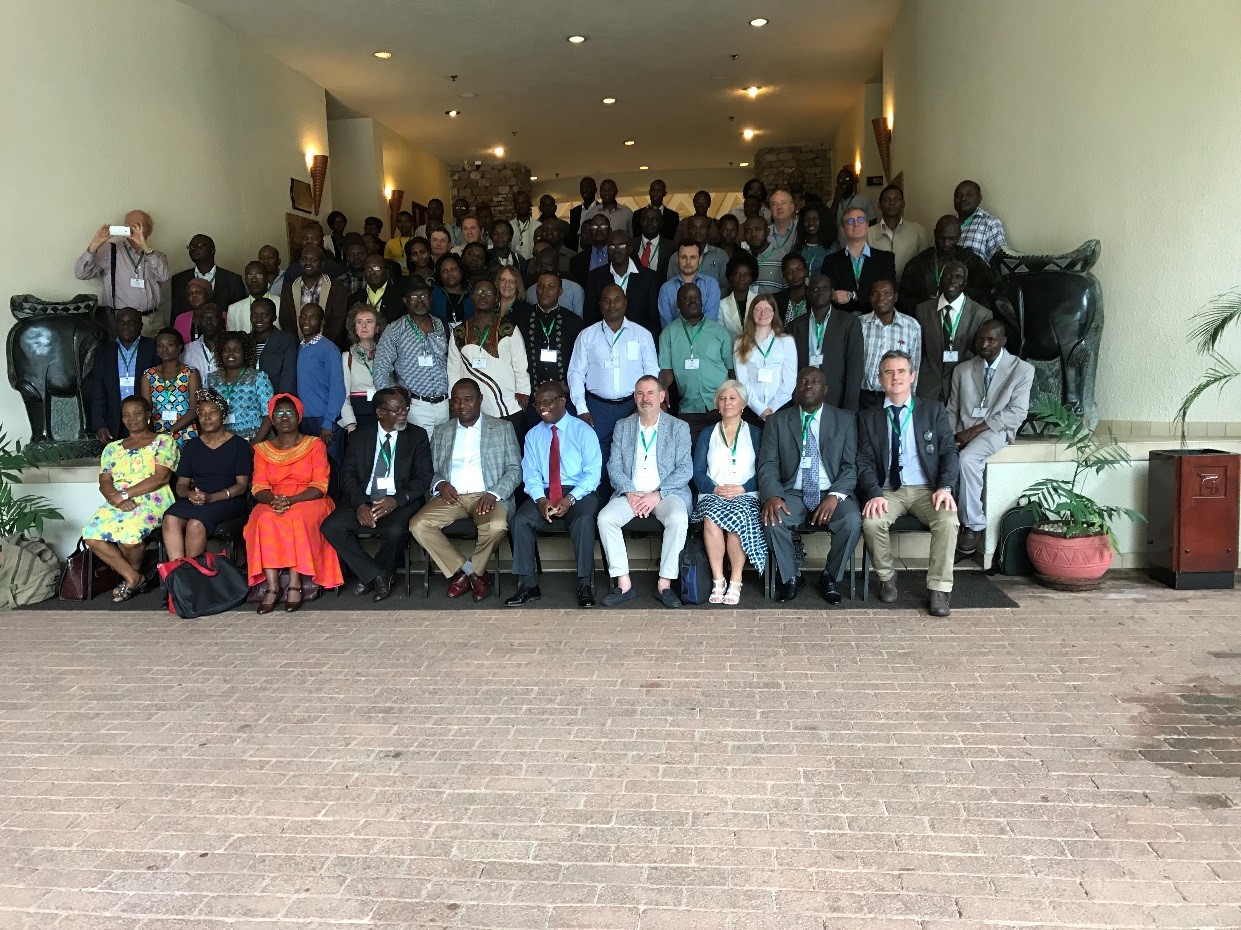
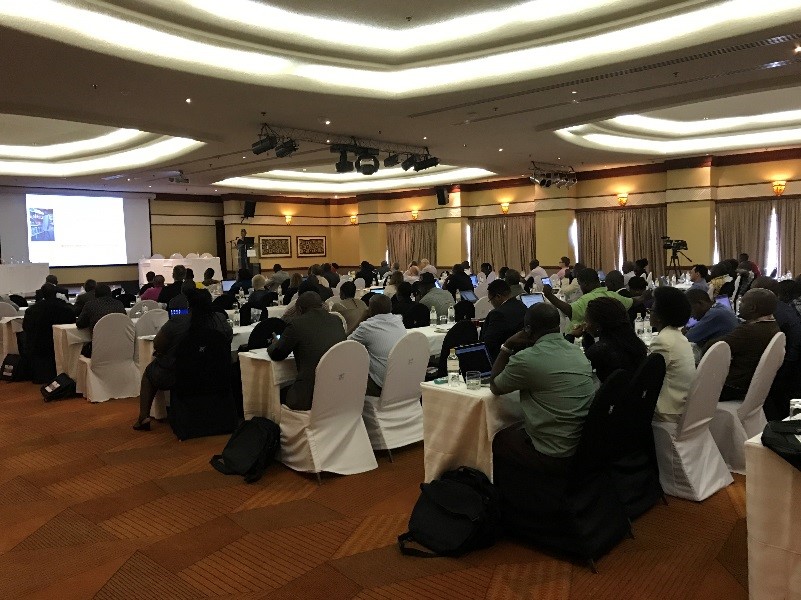
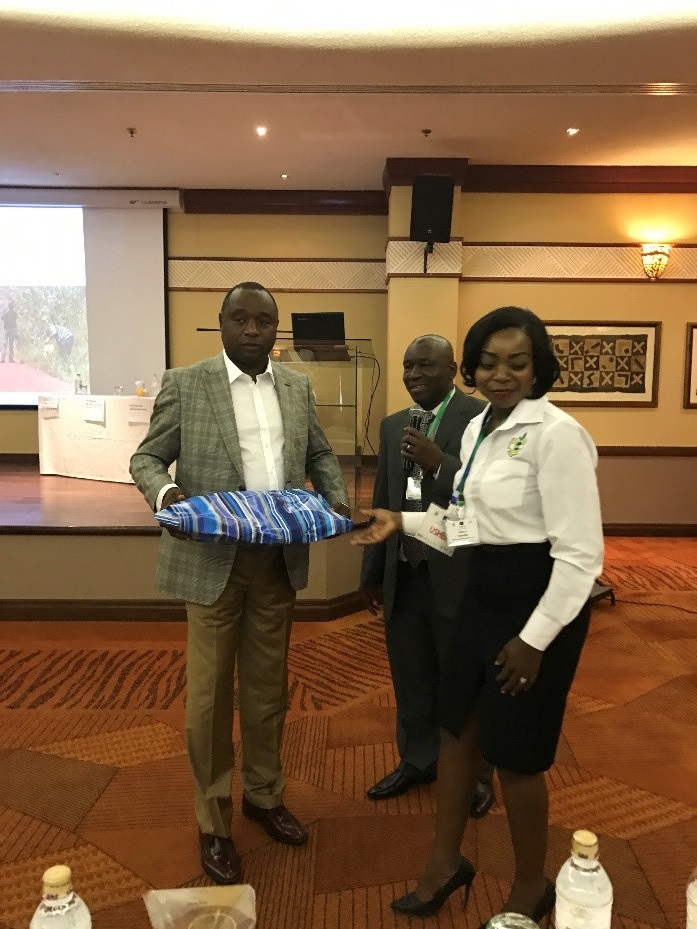
October 2016
OPTIONs team meets for its 3rd annual meeting in Lilongwe, Malawi, hosted by project partner Mzuzu University. Project progress over the last year and plans for the 2nd International Conference on Pesticidal Plants were discussed.
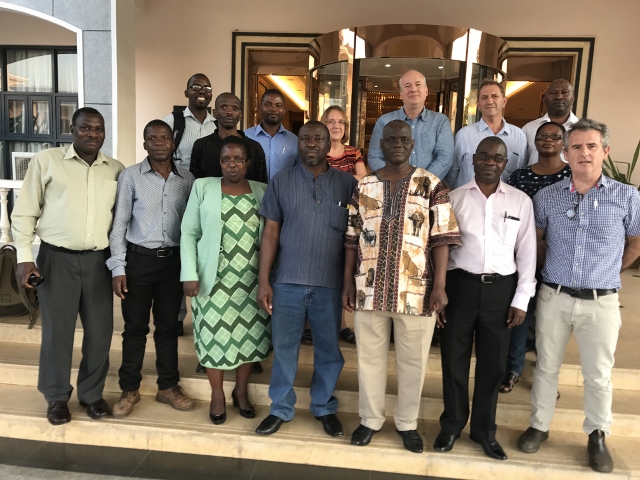
Melia volkensii plants that were planted at Nzouni in Makueni county, Kenya in November 2015. The seedlings were purchased from Makueni OPTIONs farmers.
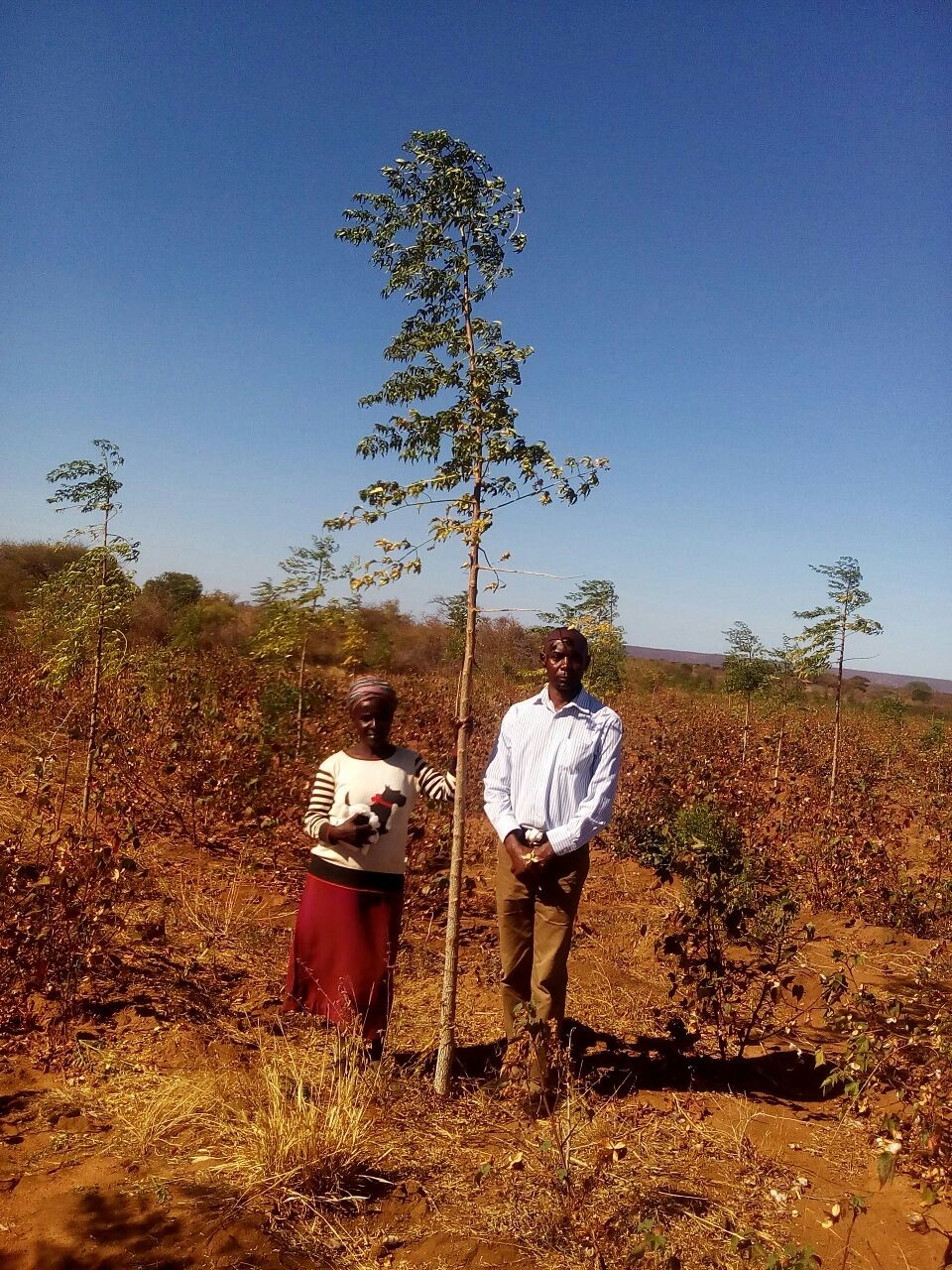
September 2016
Training session for Tharaka farmers by National Museums of Kenya researchers Dr. Patrick Muthoka and Dr. Esther Kioko on propagation, use of pesticidal plants and beneficial/ harmful insect pests.
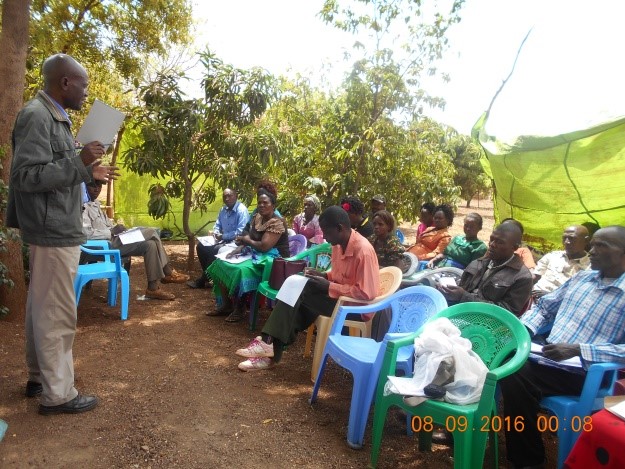
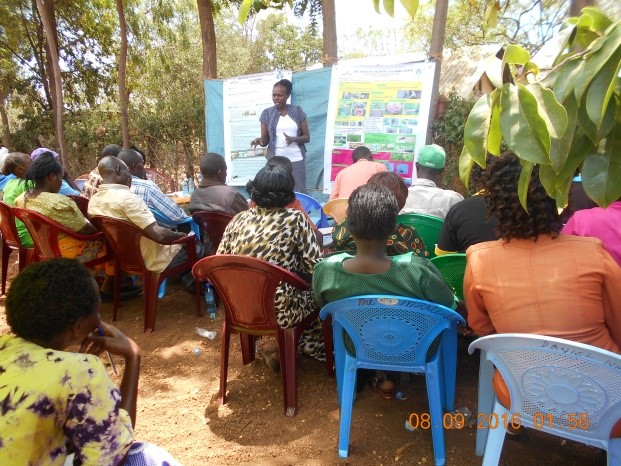
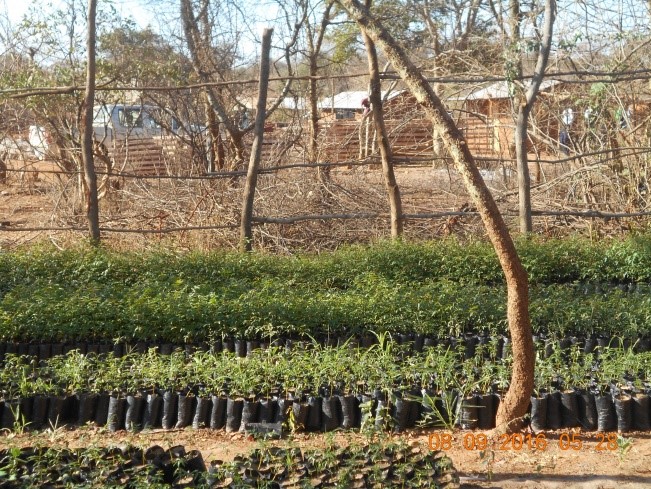
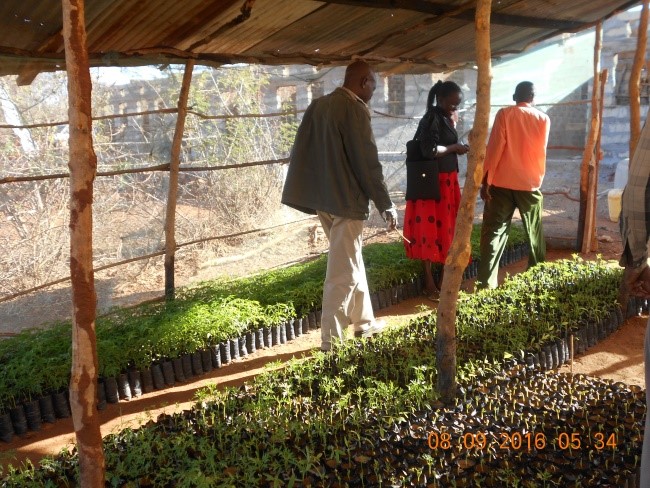
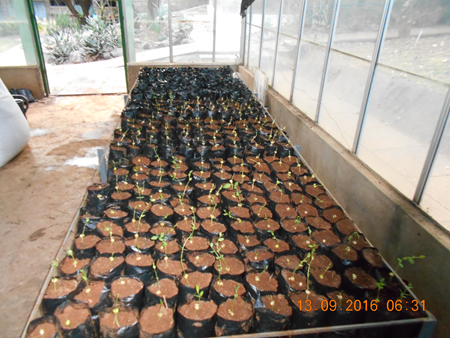
August 2016
OPTIONs partner National Museums of Kenya helps farmers learn how to propagate Securidaca longepedunculata. Commonly known as the Africa violet tree, Securidaca is one of the best indigenous pesticidal species, but until OPTIONs research it was considered very difficult to propagate.
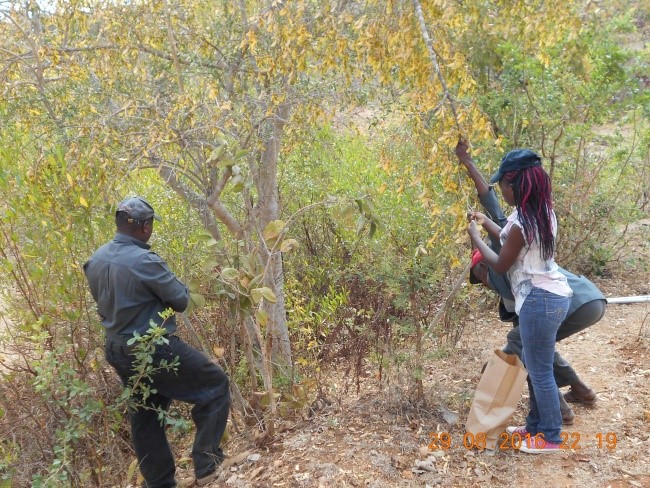
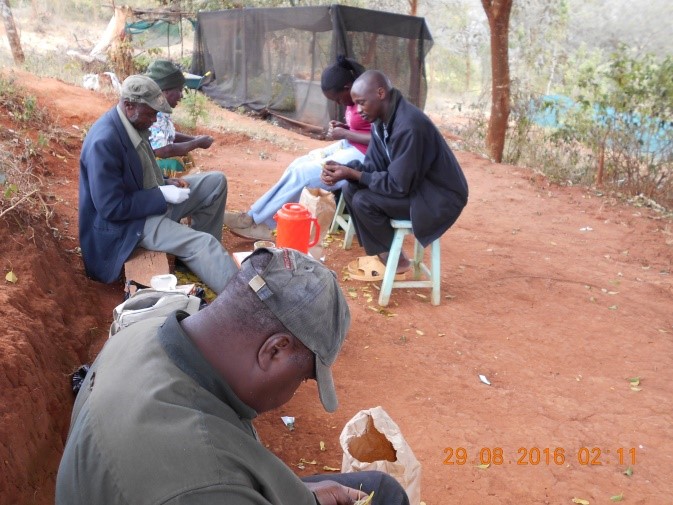
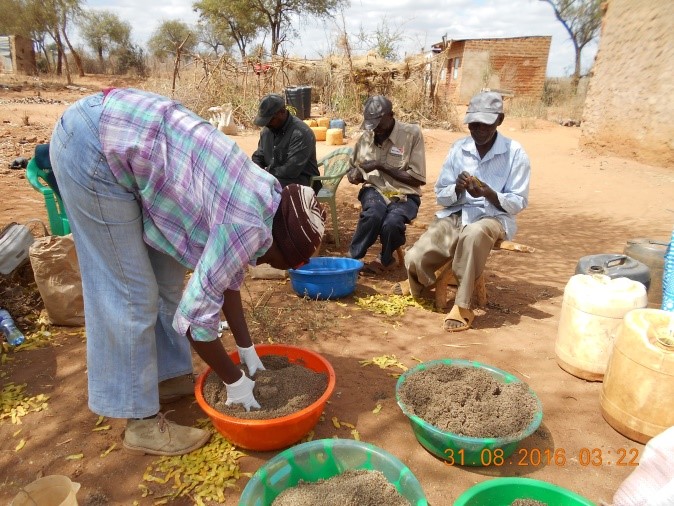
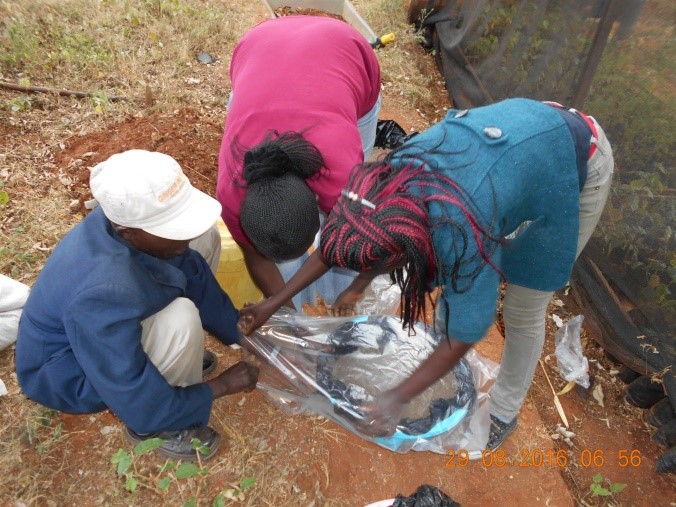
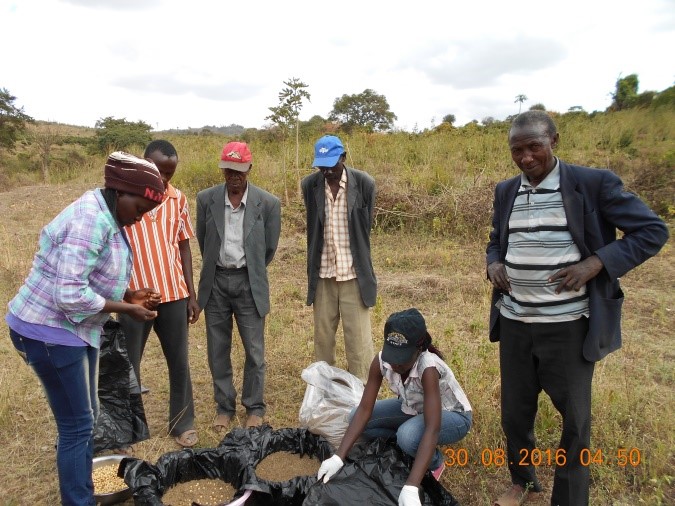
July 2016
OPTIONs partner National Museums of Kenya carries out a series of farmer training events in western Kenya.
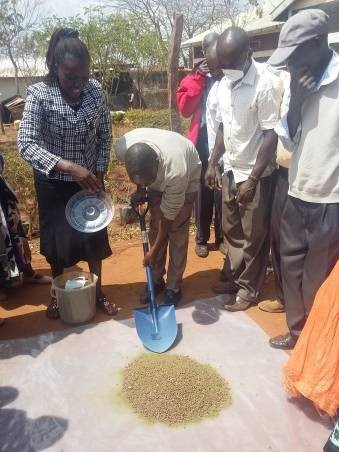
June 2016
A practical publication is produced by OPTIONs colleagues at the World Agroforestry Centre: Handbook on Pesticidal Plants. The book can be dowloaded from here and can also be found on the ICRAF online library.
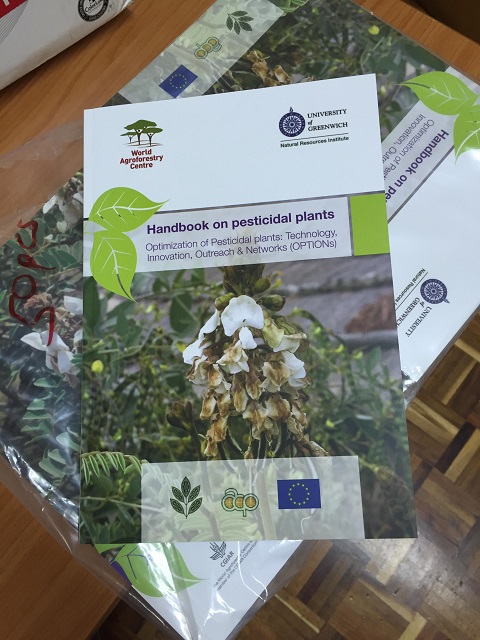
May 2016
A training workshop with more than 60 farmers from Western Kenya took place at the National Museums of Kenya over the 25th and 26th May. Training was provided on how to use pesticidal plants, giving farmers practical hands-on experience in making their own extracts. The event was broadcast on Kenyan national news by TV channel KBC as well as in several newspapers.

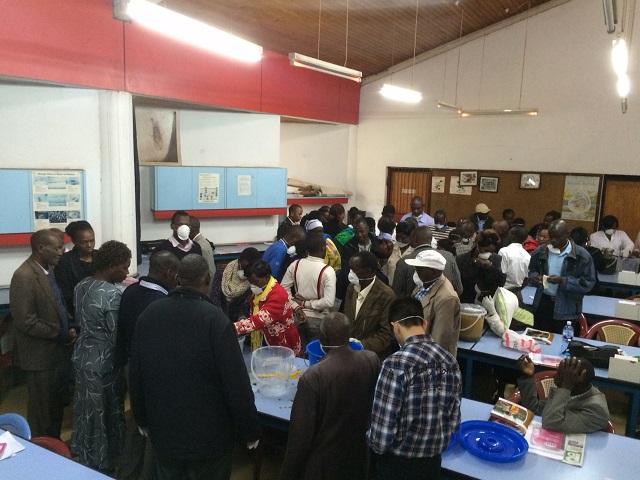
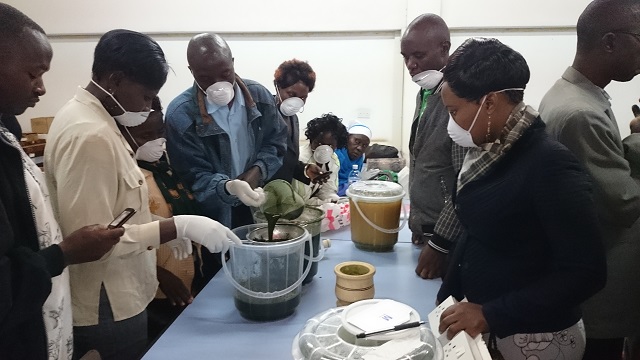
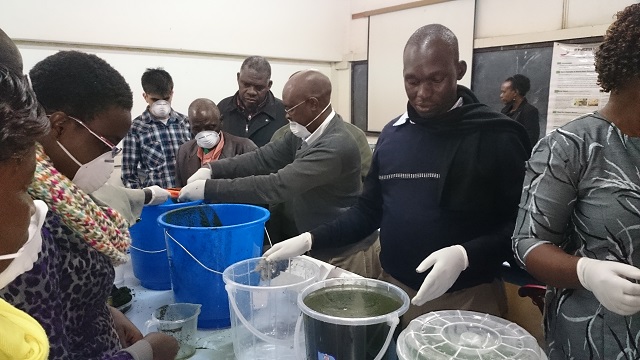
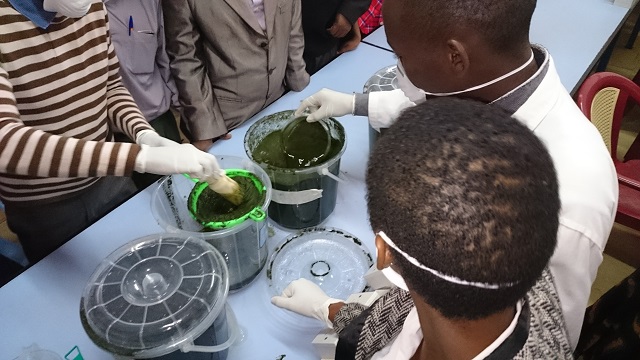
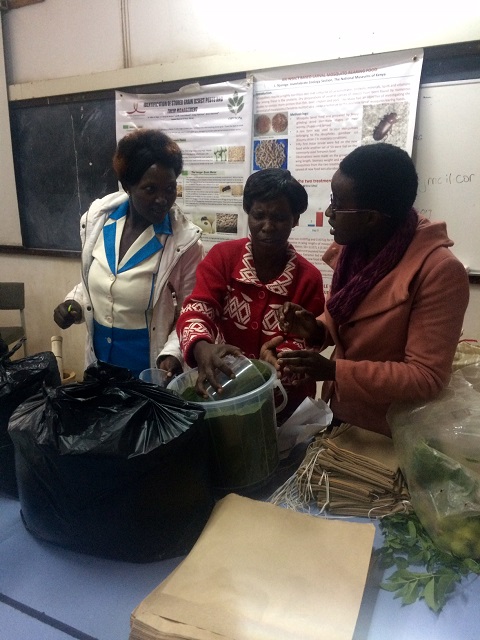
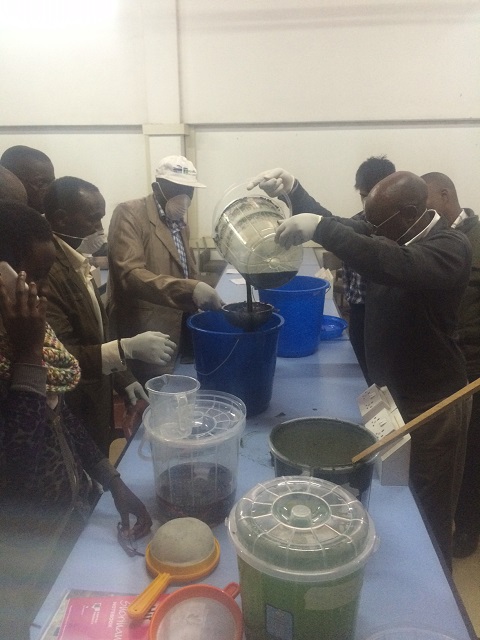
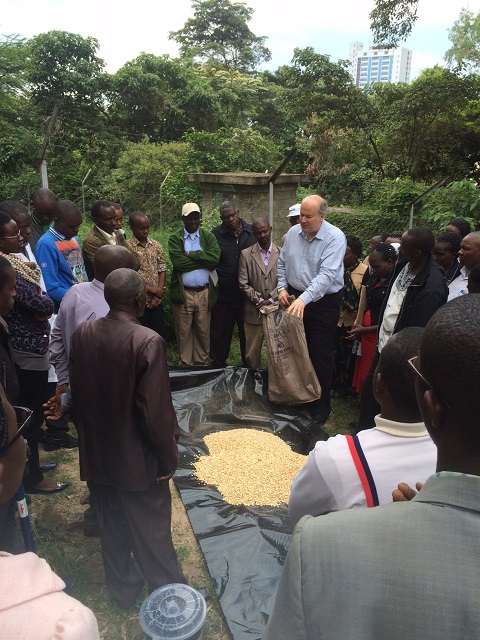
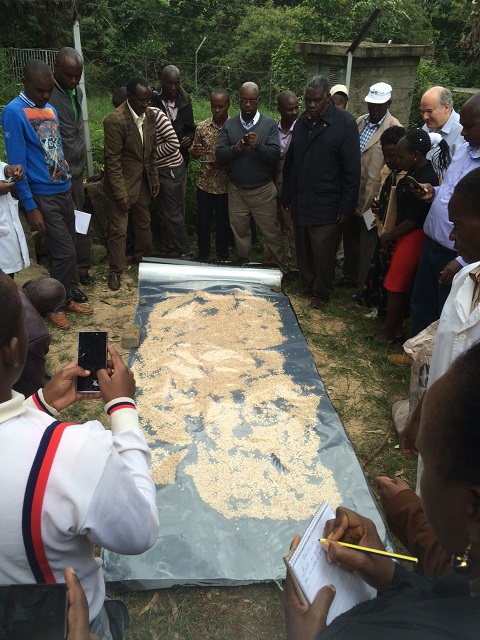
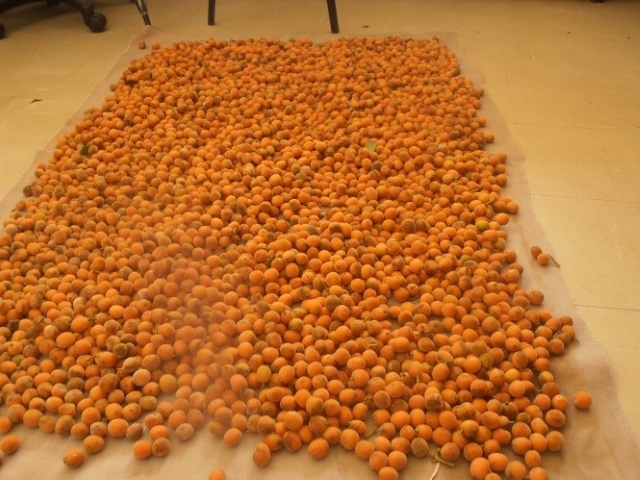
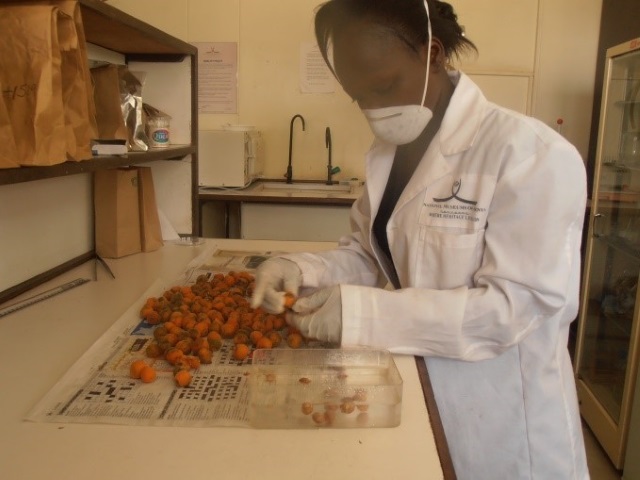
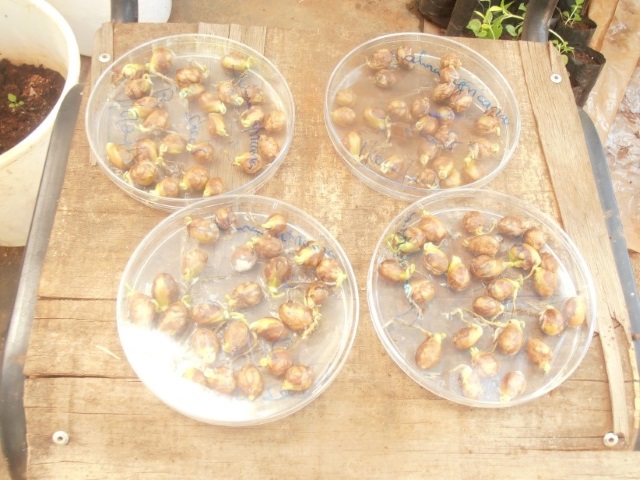
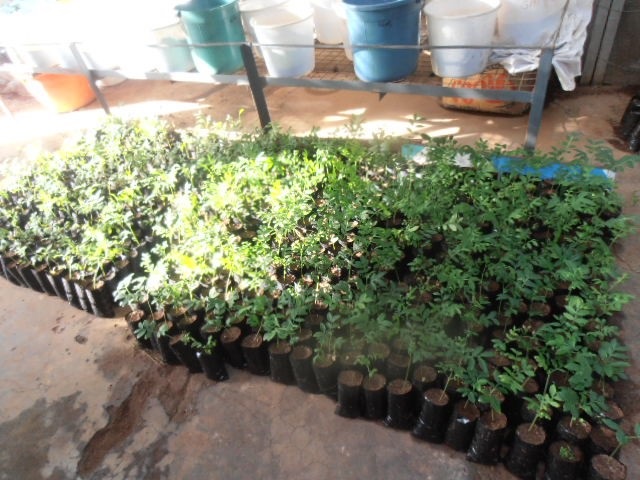
April 2016
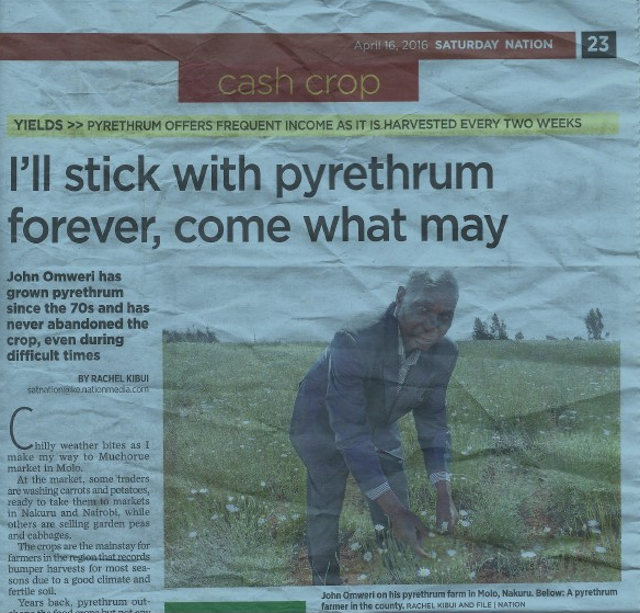

March 2016
Training session for farmers from Tharaka, Kiuuku, Nzouni, Busia, Ngutwa, Kivani and Kaiti at Mr. Kituku’s Melia volkensii plantation in Kibwezi. Mr Kituku has planted over 18,000 seedlings of Melia volkensii for timber. He also uses leaves of Melia volkensii as a mulch against termites. The training was organized by OPTIONs partner National Museums of Kenya with Sustainable Global Gardens as participants.

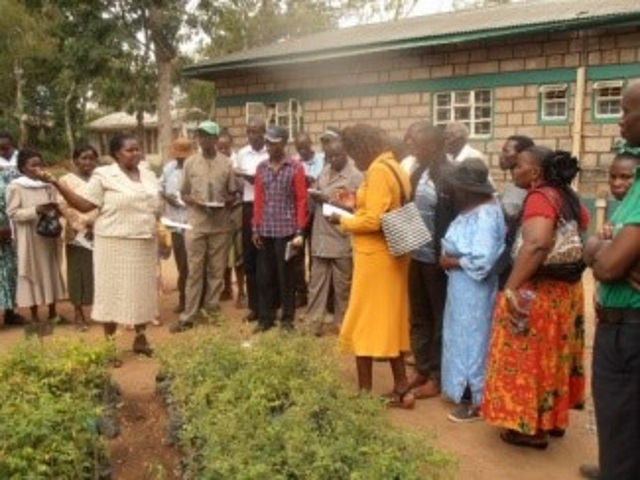
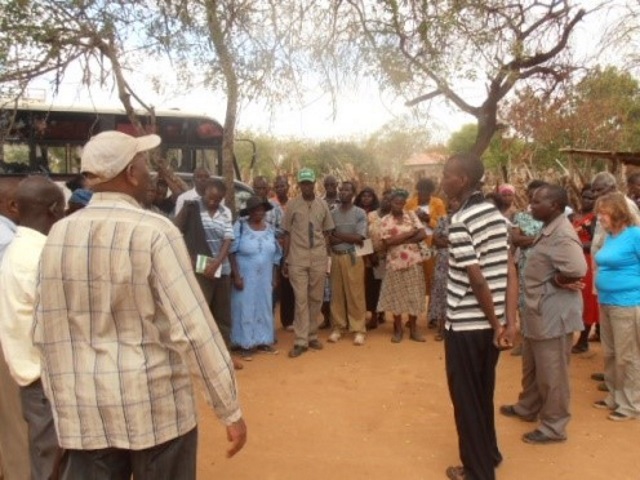
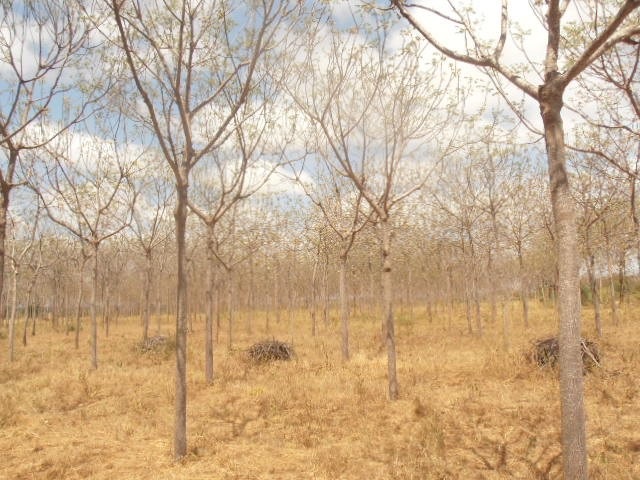

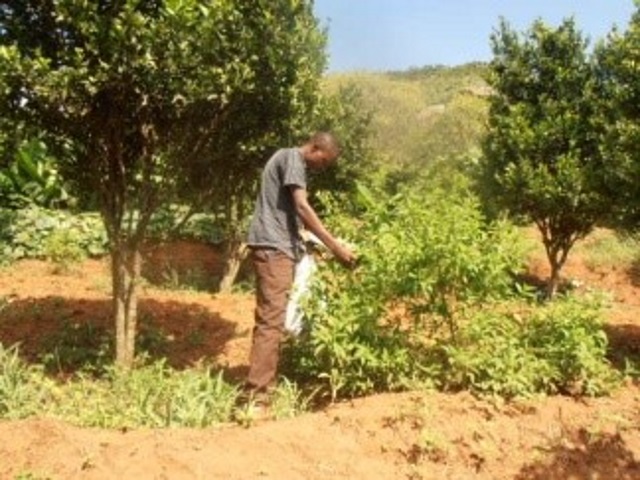
February 2016
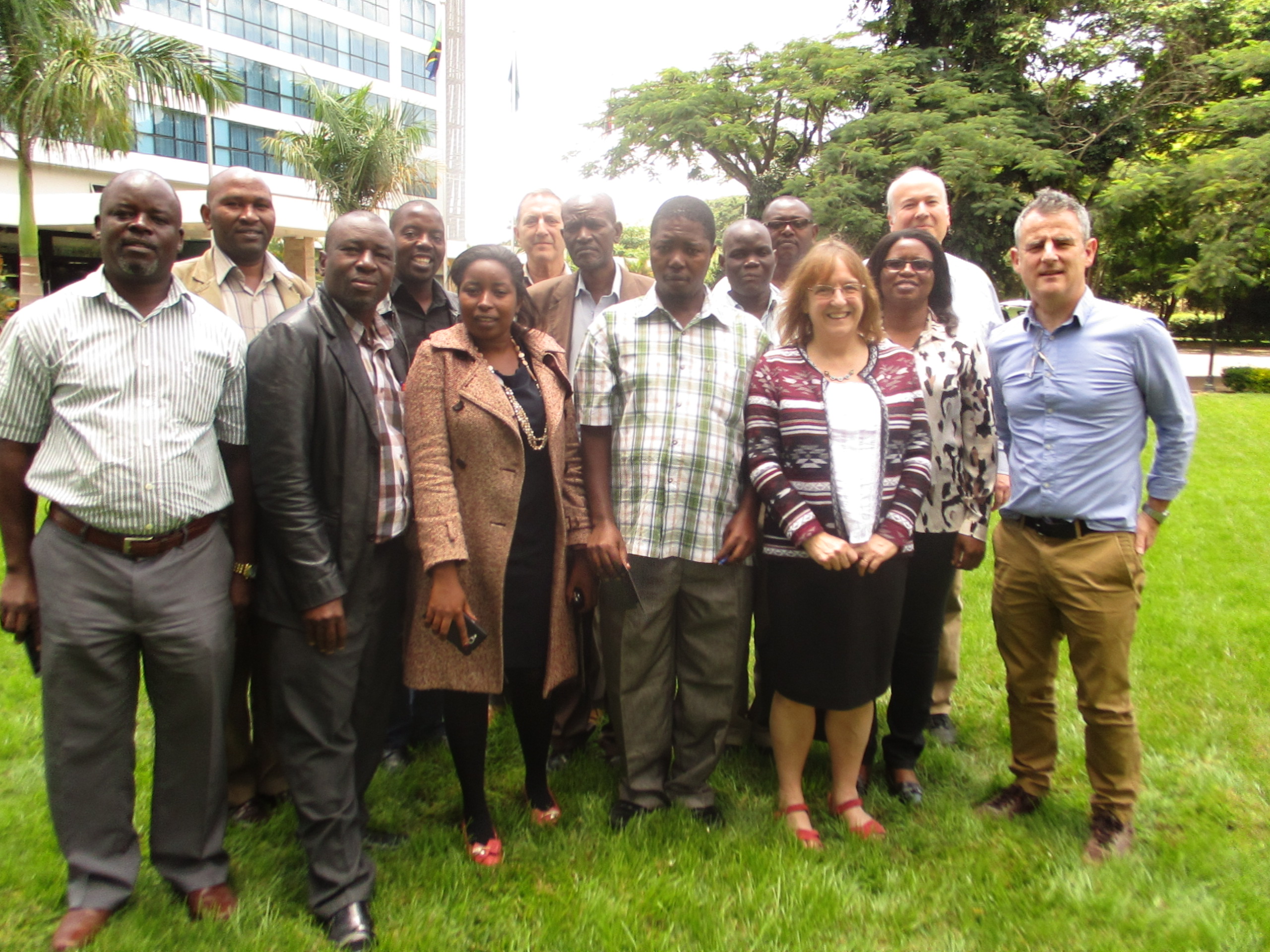
December 2015
New OPTIONs-supported research published in the open-access journal PLoS ONE is highlighted in an NRI press release
The full publication can be found here: Mkenda, P., Mwanauta, R., Stevenson, P. C., Ndakidemi, P., Mtei, K., and Belmain, S. R. (2015). Extracts from field margin weeds provide economically viable and environmentally benign pest control compared to synthetic pesticides. Plos ONE. 10(11), e0143530. (full text pdf)
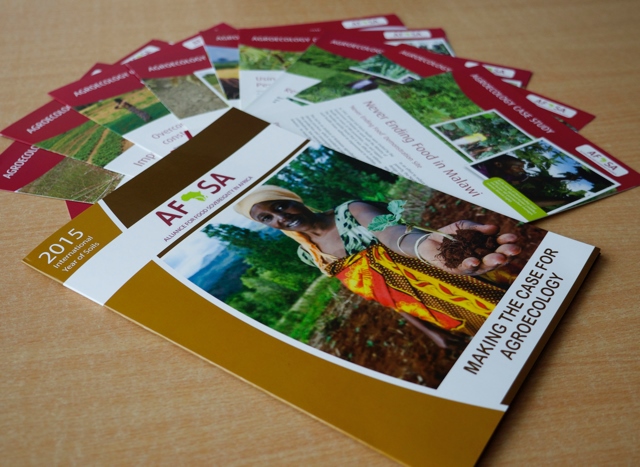
November 2015
OPTIONs partner Sustainable Global Gardens has been busy demonstrating the use of pesticidal plants with farmers and schools in western Kenya. Through such outreach, the pesticidal plant Tephrosia vogelii has been planted widely through developing local nurseries and tree planting schemes. As an indigenous tree, Tephrosia helps improve the soil through its roots fixing nitrogen and mining minerals. Extracts made from the leaves can be used to control insects on most crops. Many schools are involved in planting the neem tree, Azadirachta indica, in their school yards.
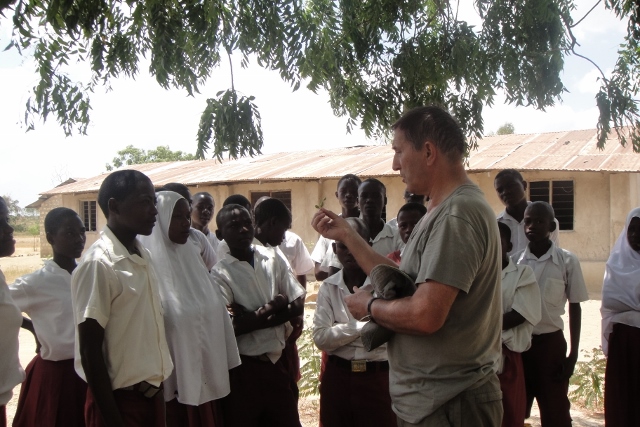
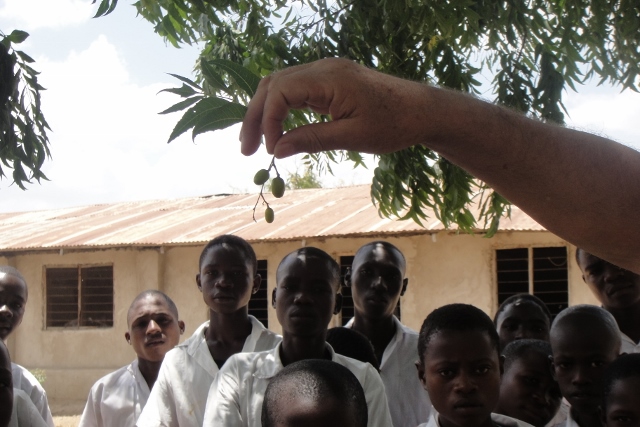
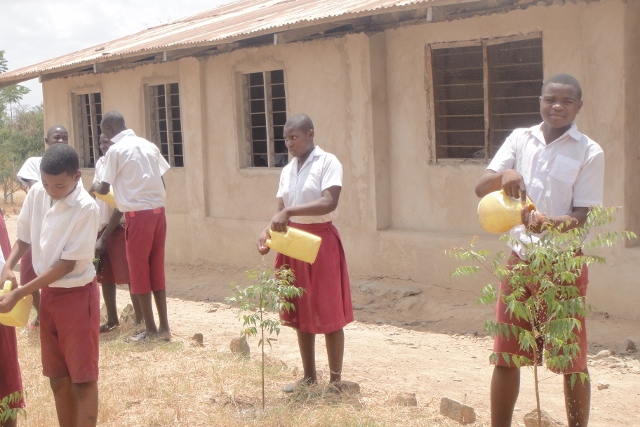
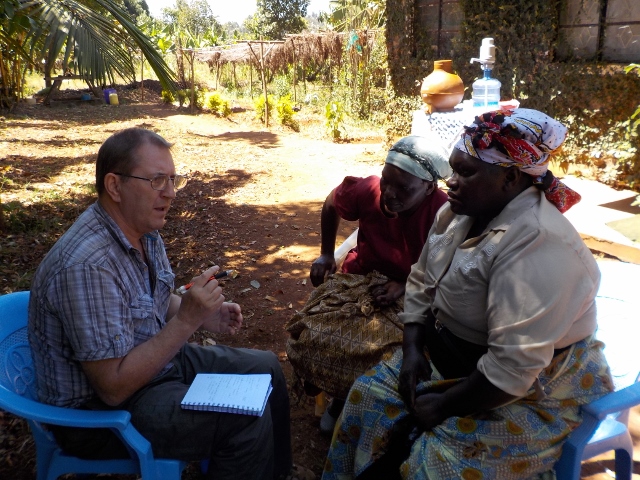
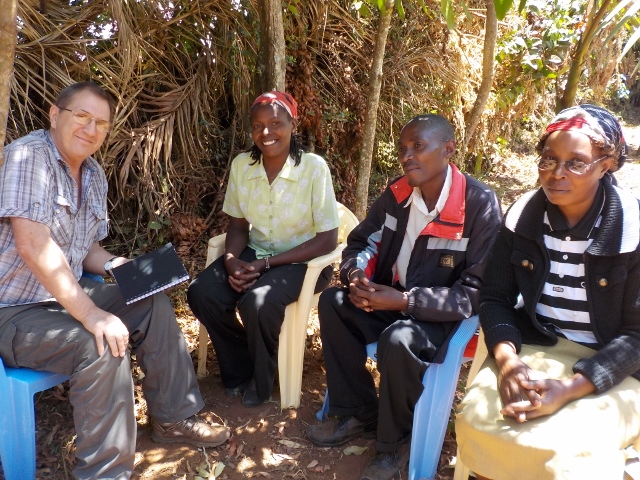
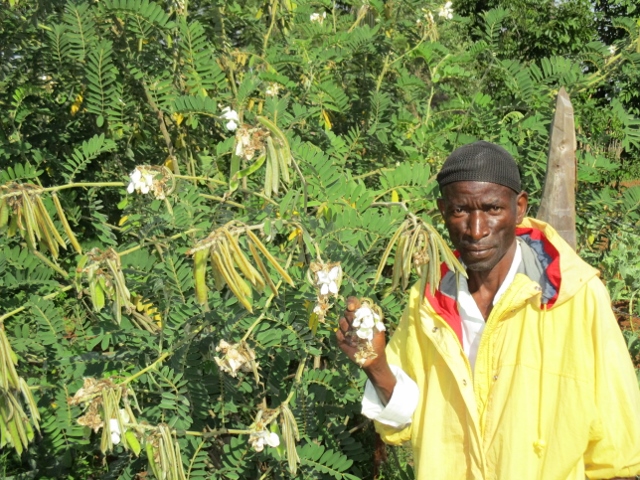
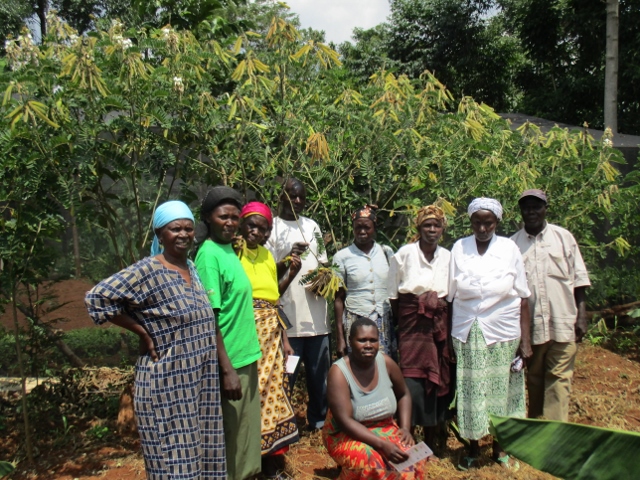
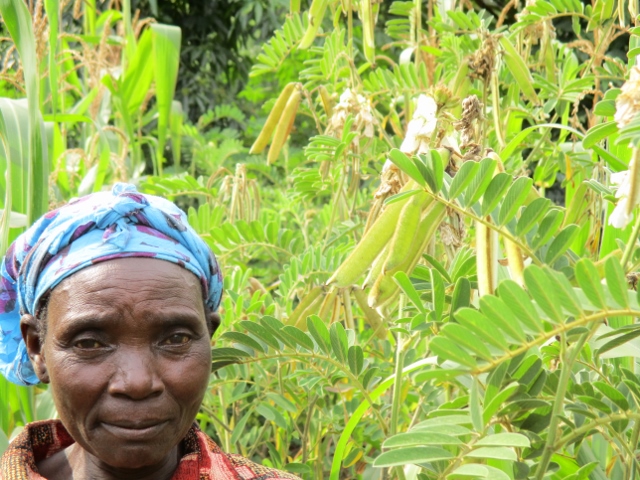
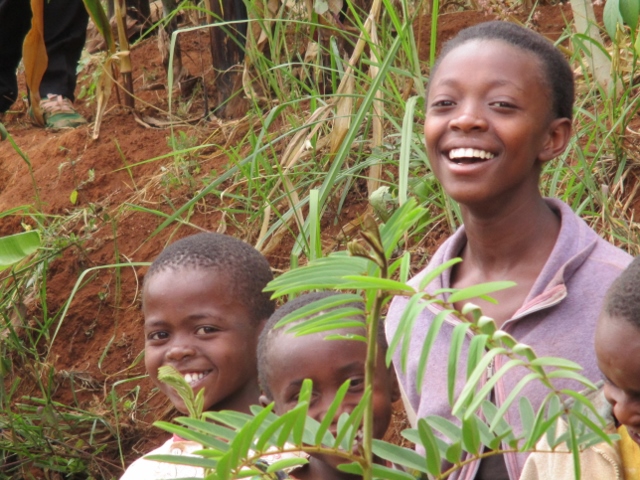
October 2015
Research staff from the East Africa Herbarium of the National Museums of Kenya have been demonstrating how to grow indigenous tree species in some of the more arid parts of western Kenya working with local communities, schools and nursery growers in Thakara, Kenya. The Herbarium team has also recently published a leaflet on the propagation of Securidaca longepedunculata, one of the target indigenous, slow-growing, recalcitrant species of the OPTIONs project.
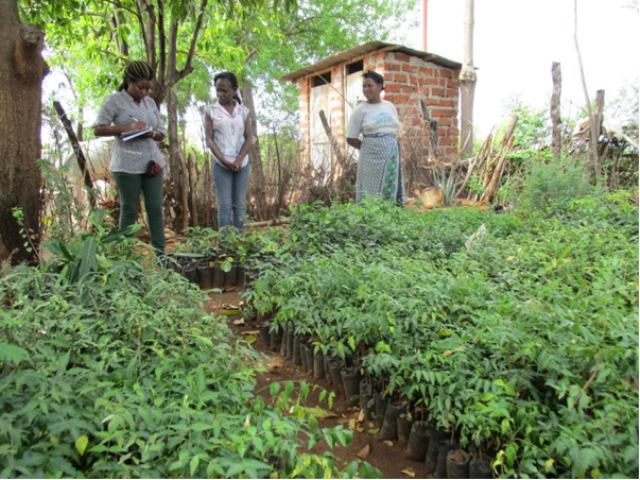
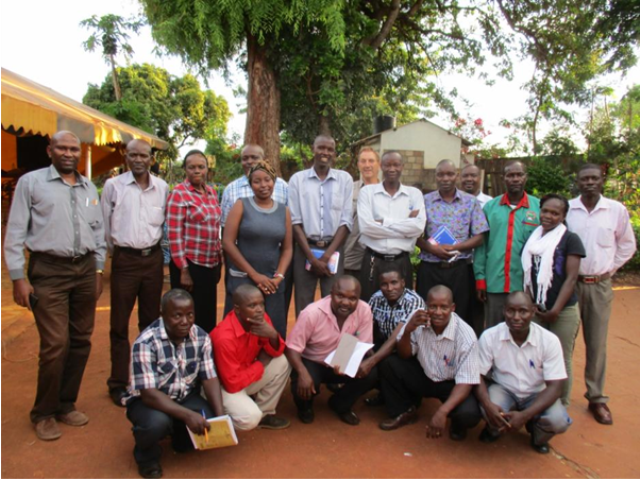
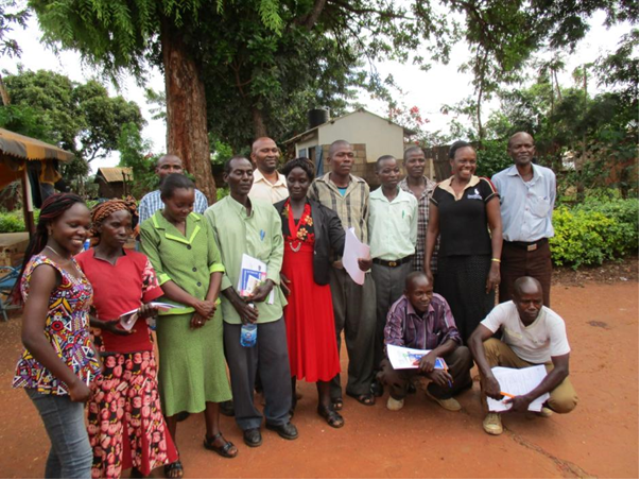
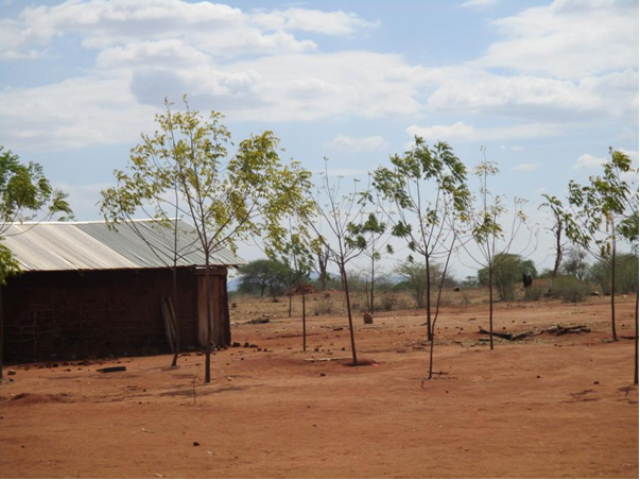
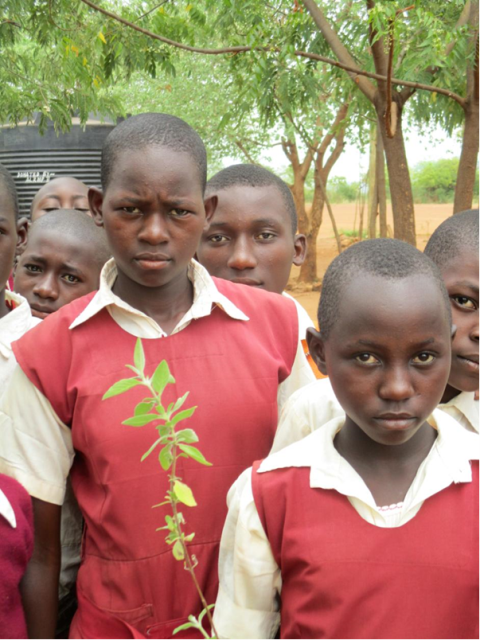
September 2015
OPTIONs project partner ICRAF publishes the Proceedings of a training workshop at the World Agroforestry Centre, Nairobi, Kenya, 28-30 October 2014.
Over 1000 farmers attended and visited OPTIONs demonstration booth that provided training on the preparation, application and use of pesticidal plants as well as demonstrations on propagation. Farmers from Machakos were very interested in being educated on pesticidal plants to protect their stored grains and crops. Some farmers had used pesticidal plants before but the majority had not previously used them.
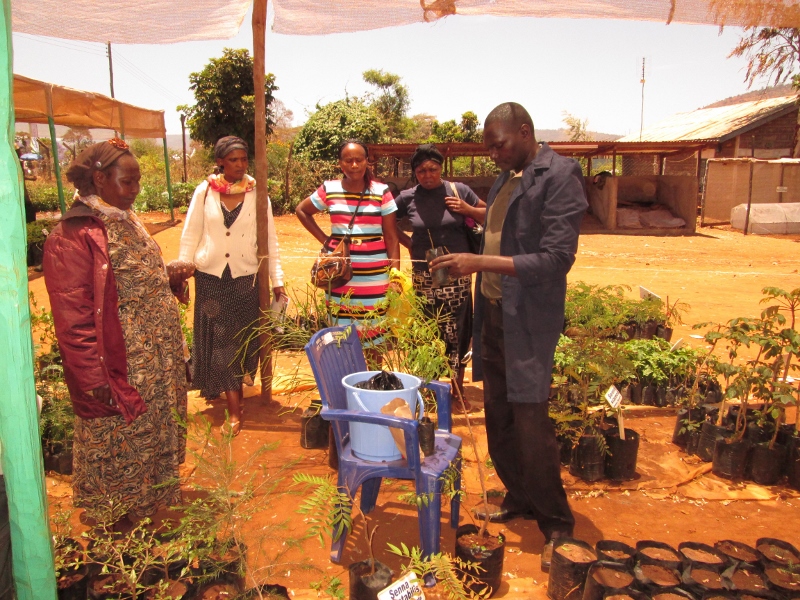
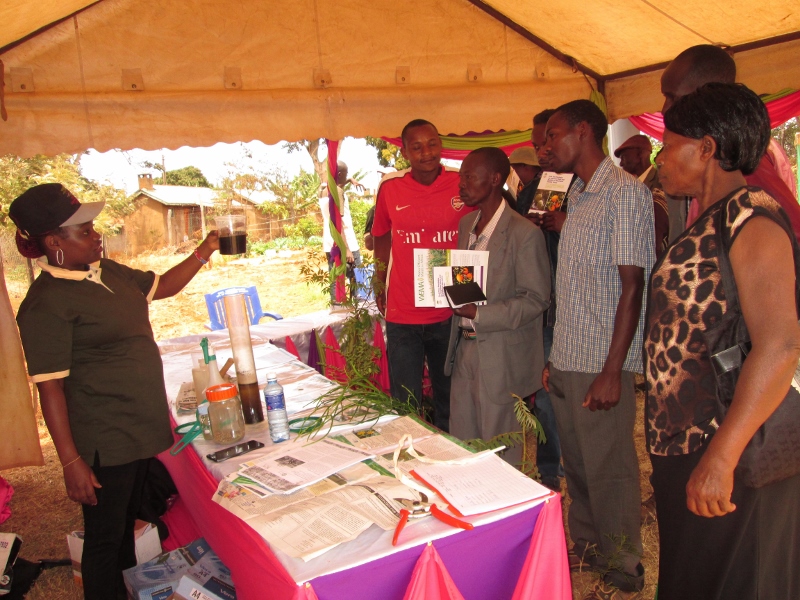
July 2015
New leaflet highlighting OPTIONs activities and partners in Kenya: OPTIONs partnership encourages farmers to grow and use natural pesticidal plants, rather than synthetic chemicals for pest control
June 2015
The OPTIONs project and pesticidal plants was showcased at the Machakos Agricultural show between 24th and 28th June 2015 in Kenya. OPTIONs partner ICRAF was privileged to participate and to have a stand at the show, hosted by the Kenyan Ministry of Agriculture. At the stand, the OPTIONs project was prominently displayed. Participants and visitors were taught about pesticidal plants and how they can be used to protect stored grains and field crops. Demonstrations on how to prepare and use pesticidal plants were performed. Several species of pesticidal plants which had been propagated at ICRAF were shown to participants and information was shared on how to grow the species. Participants were also given leaflets on pesticidal plants. Visitors were particularly interested in the preparation of the plants for use on field crops. They mentioned that pests were a main problem in achieving food security in the region and acquiring synthetic pesticides was a financial challenge for many of them.
More than 640 participants recorded their name and interest in the OPTIONs stand. Out of these participants, more than 250 of them were female. More than 130 of them were linked to a nursery, more than 150 were linked to a farmer group and 83 participants mentioned that they had used pesticidal plants before. Participants came from various backgrounds; more than 440 were farmers from the Machakos region and from farmers groups all over Kenya, more than 130 were from educational institutions (teachers, students, scientists), some were from the various government ministries and institutions (Ministry of Agriculture, Ministry of Livestock), some were from private companies (Agrovets, fruit sellers, businessmen, pharmaceutical companies), from religious institutions and from CBOs.
More than 2900 fact sheets on pesticidal plants were distributed to participants who expressed interest. Many of the participants expressed the need for further training on pesticidal plants to reach their communities which were faced with pest problems and post-harvest losses due to pests. Some participants returned to the stand with their fellow farmers on subsequent days for information sharing and training at the stand.
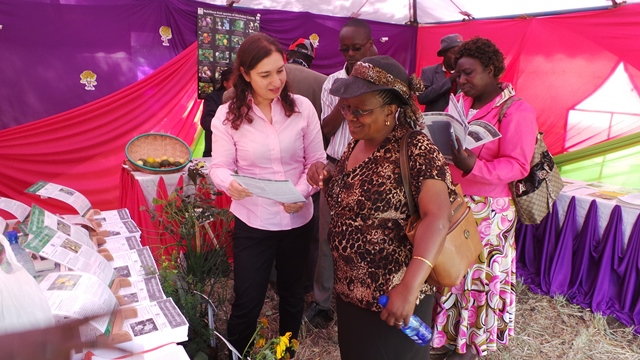


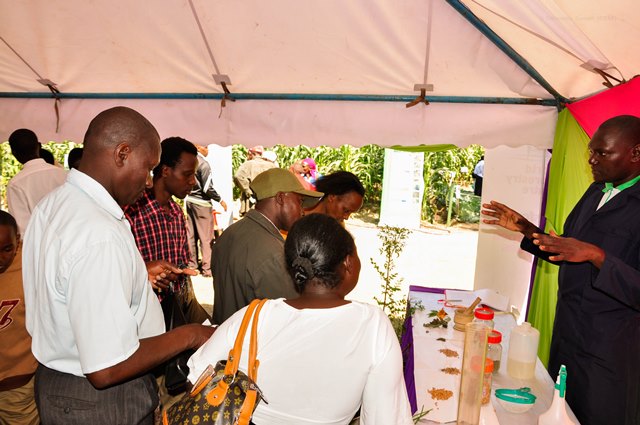
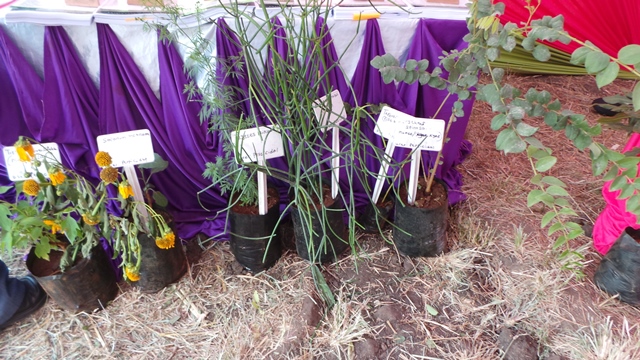
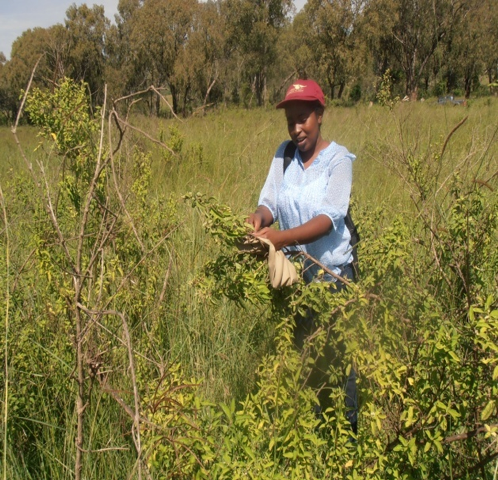
May 2015
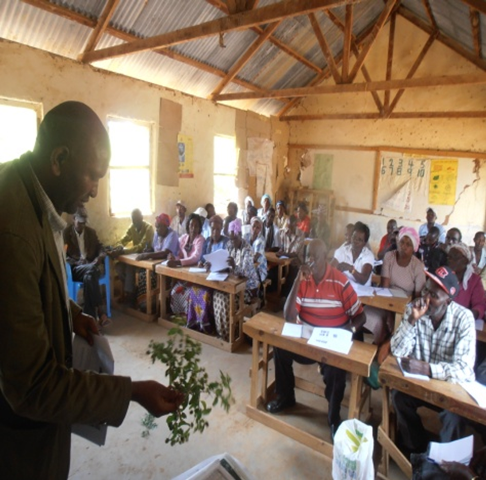
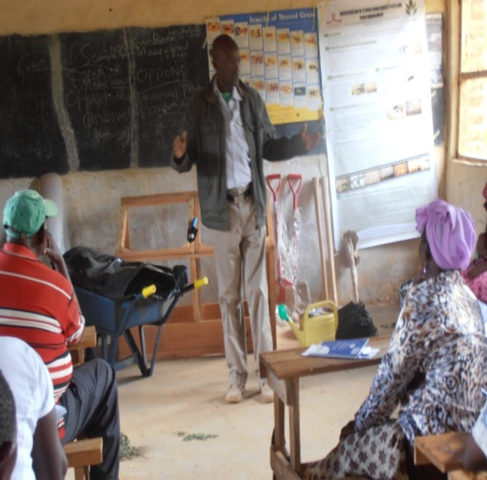
April 2015
New article appearing on the ENSIA web magazine, Could traditional plants hold the secret to saving crops from pests? Researchers build on age-old practices to reduce food loss in Africa.
February 2015
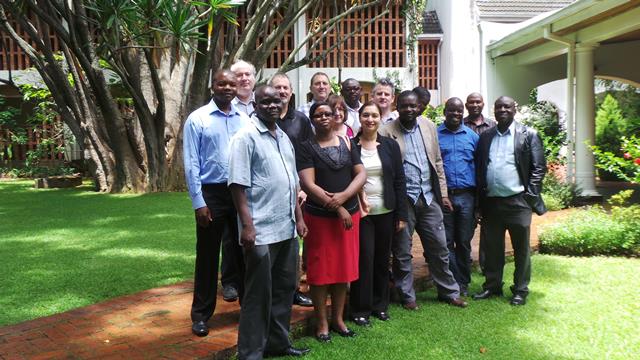
The first annual meeting of the OPTIONs project took place in Harare, Zimbabwe, from the 2nd to 4th February, hosted by the University of Zimbabwe (download Minutes of the meeting). The team reviewed progress over the past year and developed detailed plans for the next two years. Of particular note, it was announced that the 2nd International Conference on Pesticidal Plants will be hosted by the University of Zimbabwe to take place in the town of Victoria Falls, Zimbabwe in early 2017. More details about the ICPP2 and a 1st circular announcement will be out soon.
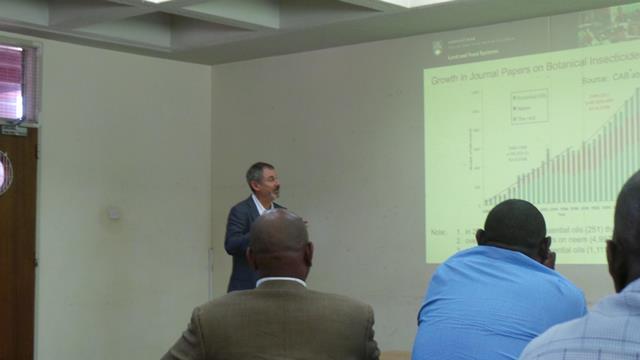
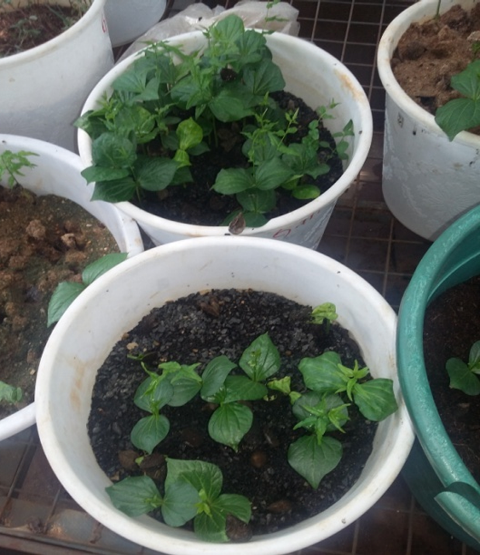
Professor Phil Stevenson from the Royal Botanic Gardens Kew and Natural Resources Institute then followed with a workshop on how to write scientific publications.
January 2015
OPTIONs pesticidal tree planting initiative is profiled in a newsletter from Sustainable Global Gardens
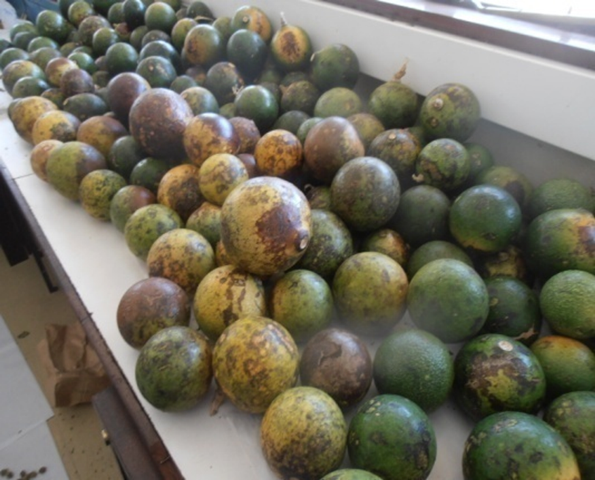
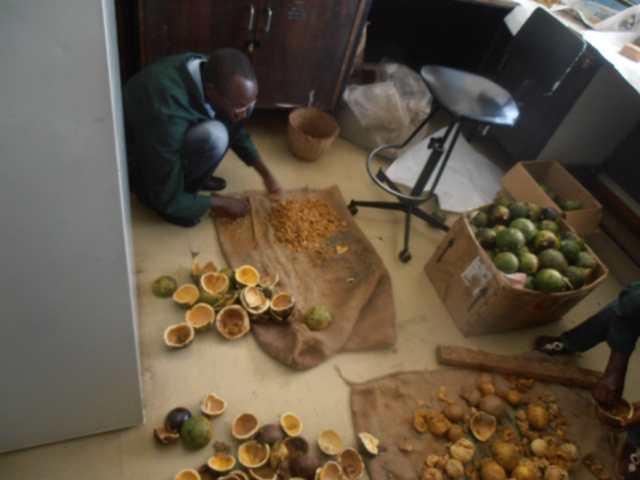
December 2014
An article about the OPTIONs workshop in October (see below) is published in The Ismaili Magazine: Pesticidal plants to protect crops and grains
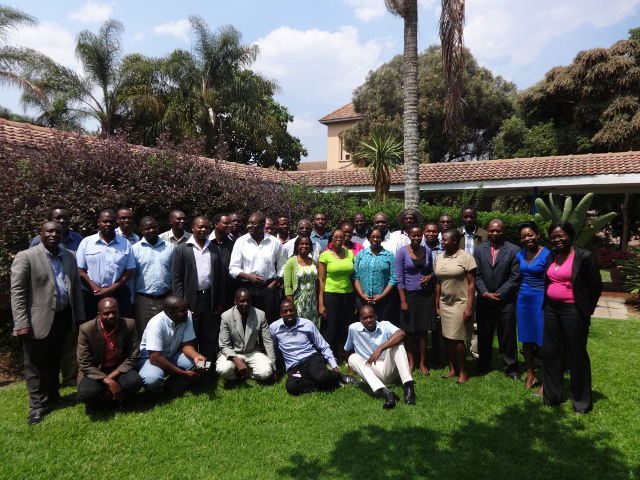
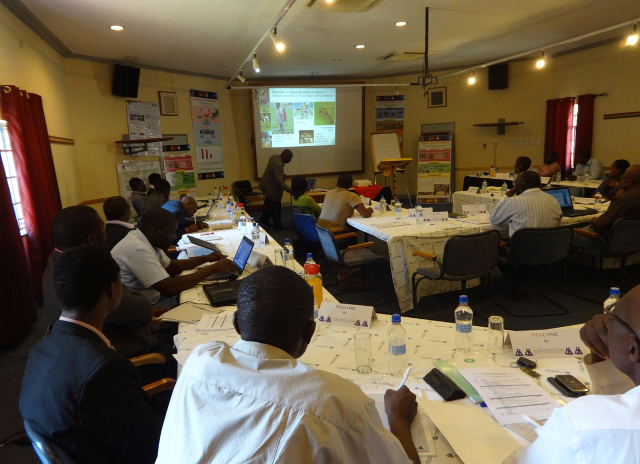
November 2014
CIFOR's Forest News highlights OPTIONs team member Dr Phosiso Sola's work on understanding policy issues in an article titled: In fight against African pests, researchers point to natural-born killers
Farmers in West Kenya have planted their pesticidal tree species on their land and are looking after them. Because Tephrosia vogelii helps improve the soil by fixing nitrogen, with its deep roots bringing up nutrients to the surface, farmers are intercropping Tephrosia with their maize to help improve their crop yields. When the Tephrosia plants are larger the farmers will be able to harvest the leaves to make pesicides and collect the seeds to increase their future propagation of Tephrosia.
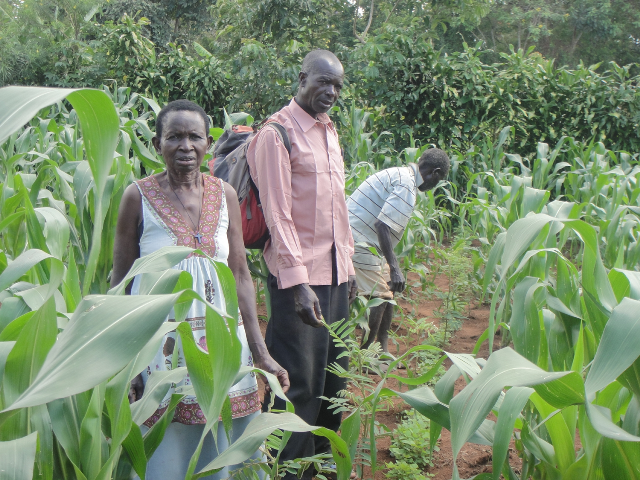
October 2014
A training workshop on how to use and propagate pesticidal plants was held at the World Agroforestry Centre. Approximately 50 people attended ranging from farmers and farmer organisations, NGOs, companies, charities and nursery growers coming from Kenya, Tanzania, Madagascar, Uganda and Mozambique. Many attendees were supported by the Aga Khan Development Network, which is supporting agroforestry projects across Africa and thus synergises with OPTIONs actions to encourage farmers and nursery growers to plant more indigenous pesticidal tree species (instead of invasive species). The main presentations made at the workshop appear on our Publications page.
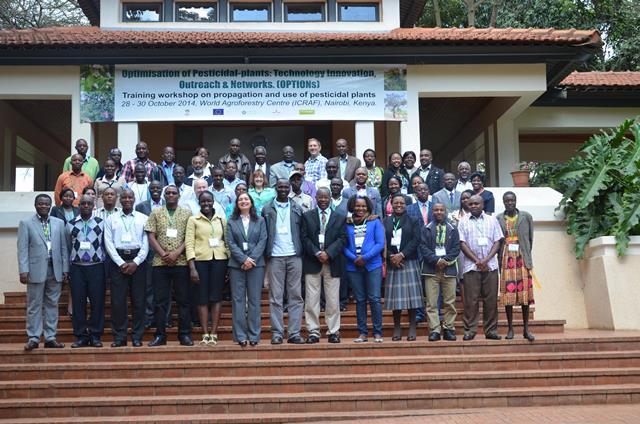
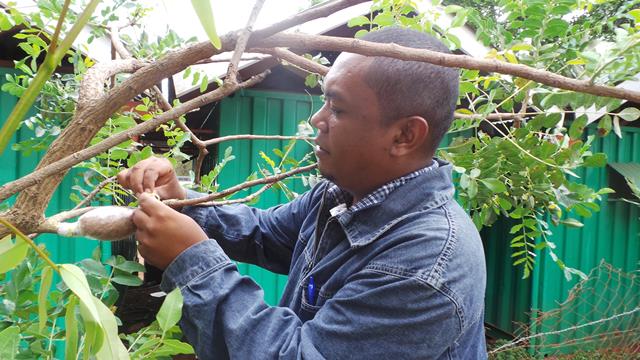
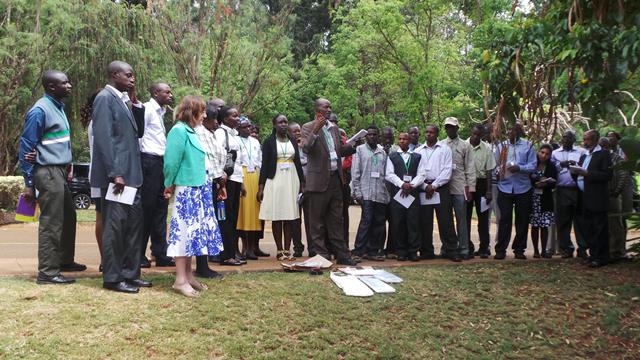
September 2014
Efforts are under way in Malawi to propagate Pyrethrum, Tanacetum cinerariifolium, and increase its potential as a cash crop in northern Malawi. Mzuzu University is currently developing a seed propagation nursery in order to increase the supply of seed material in the country that can be distributed to farmers. As one of the best known pesticidal plants, Pyrethrum could be widely used both for the production of organic produce for export as well as to help local farmers protect their crops from pests more cheaply than if resorting to commercial synthetics.
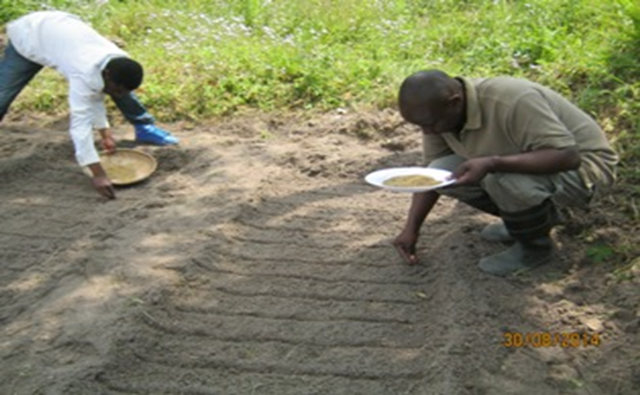
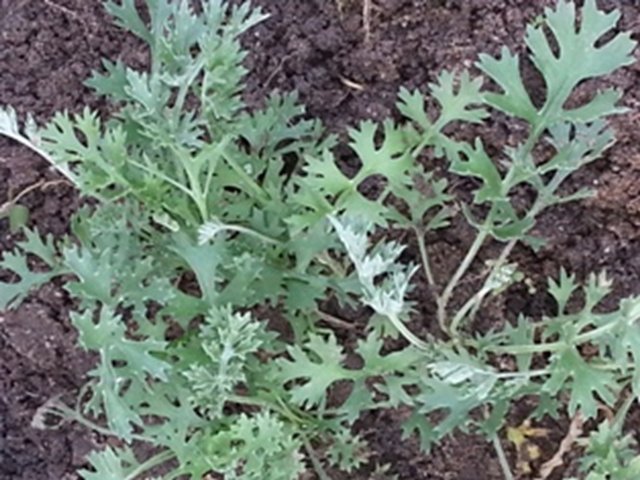
August 2014
In order to increase supply of pesticidal plant materials as well as encourage forestation programmes to use indigenous species, farmers in West Kenya receive pesticidal tree species such as Tephrosia vogelii.
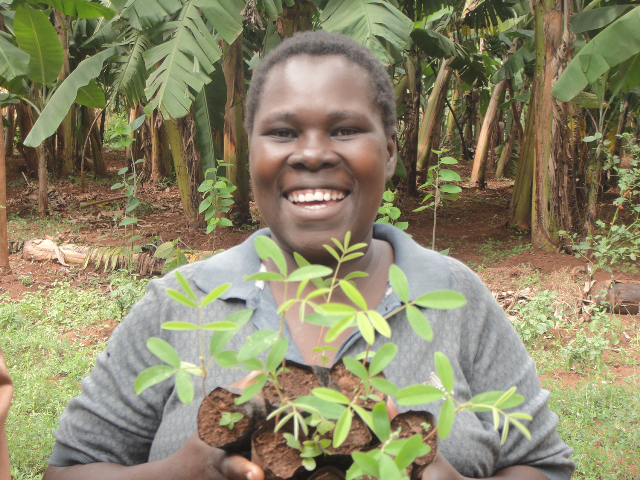
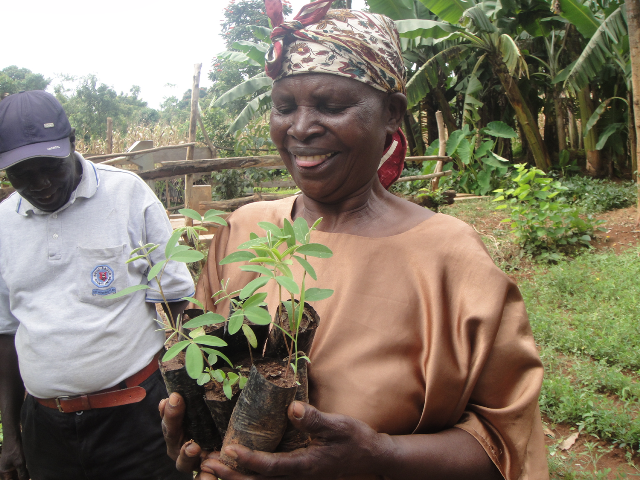
July 2014
The Maendeleo Mashinani Organisation in Busia, western Kenya acted as a pilot group and were the first farmer group to sow seeds in June.
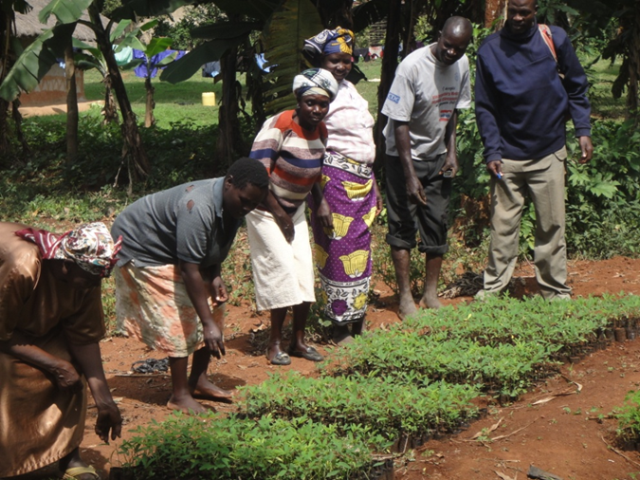
June 2014
Baseline surveys were carried out in a number of communities. Three individuals from each of 42 member groups answered questions concerning what pest problems they had and what methods they used to reduce pest damage. What these baseline surveys established is that the majority of farmers here had limited knowledge of pesticidal plants. Most relied on traditional non-plant methods [eg. smoke, ash, dung] or synthetic chemicals. Generally there was much criticism of such chemicals, but most farmers felt forced into using them. There seems to be many who would use pesticidal plants, if they had more training and appropriate information.
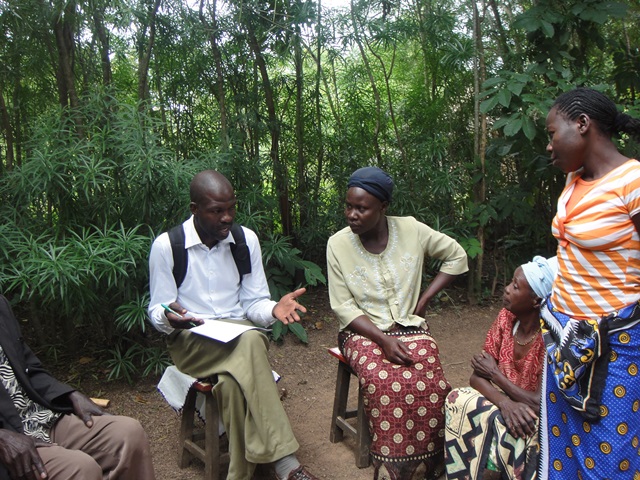
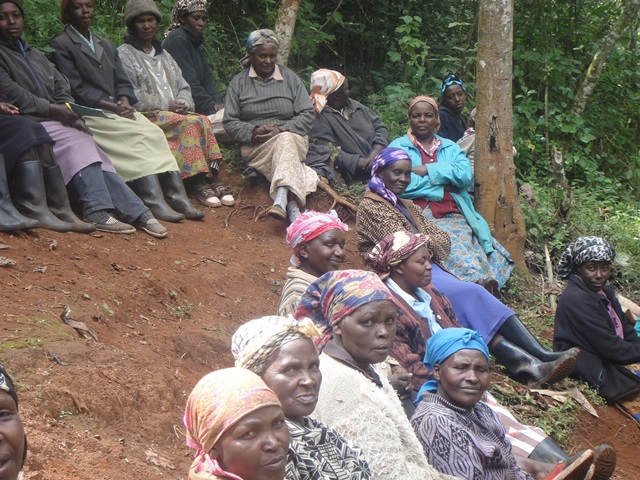
May 2014
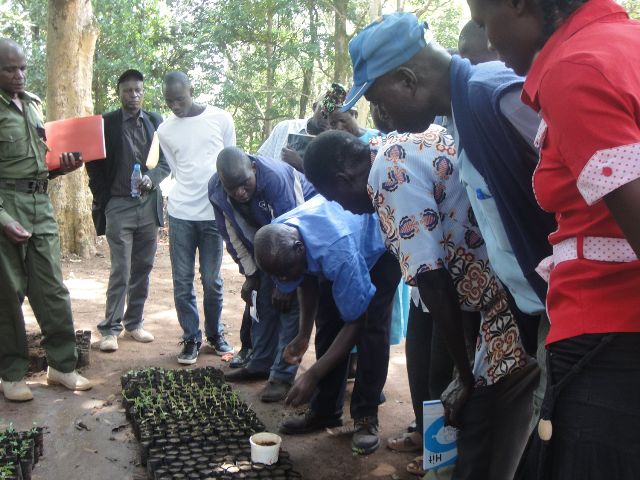
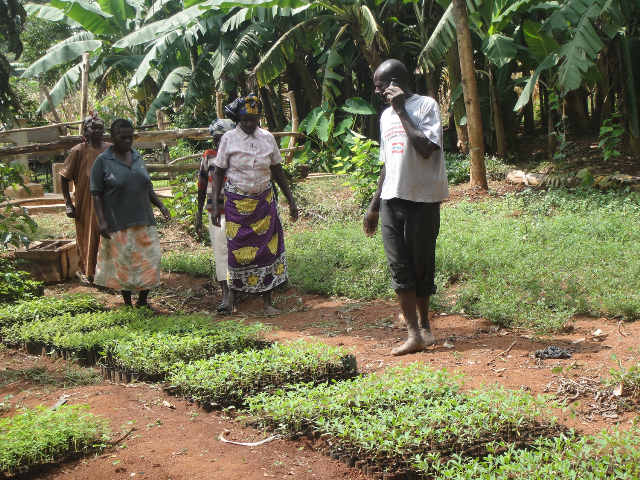
April 2014
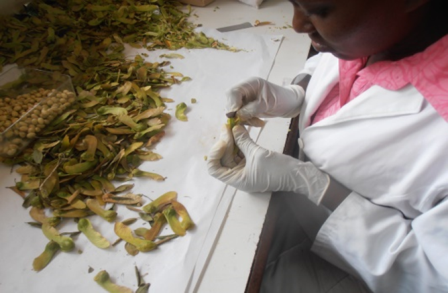
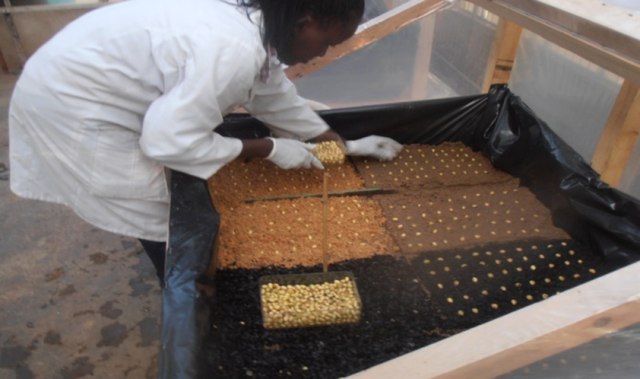
February 2014
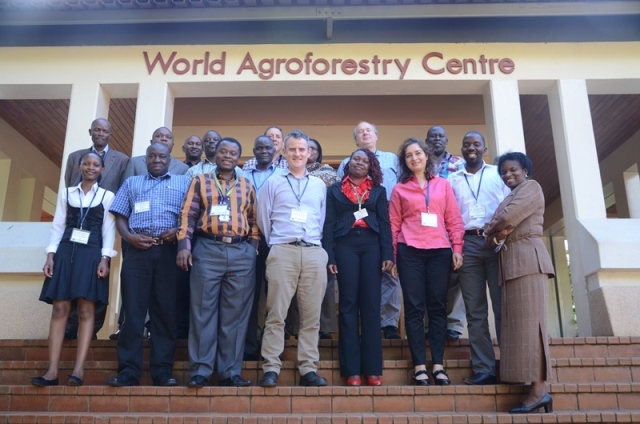
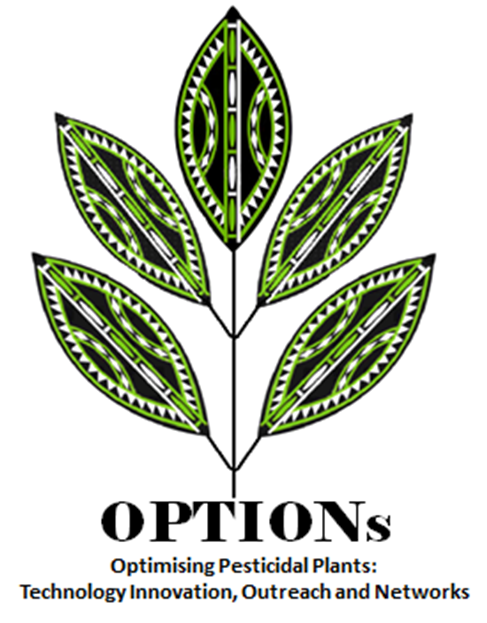
What is OPTIONs about?

Optimisation of Pesticidal-plants: Technology Innovation, Outreach & Networks, or OPTIONs for short, is a project about helping African farmers with the many pest control problems they face during crop production, post-harvest storage and protecting their livestock from ticks and fleas. Building on the long tradition of using plants with pesticidal properties, OPTIONs aims to optimise the way pesticidal plants are used and to ensure that scientific innovations developed are appropriate, sustainable and effective.
Improving technology innovation means investigating issues related to both the supply and demand for pesticidal plants and OPTIONs has several activities related to overcoming bottlenecks in terms of know-how as well as directly addressing practical constraints. For example, many pesticidal plant species have suffered from habitat degradation due to overgrazing, uncontrolled bush fires, over-collection and timber collection. The OPTIONs project is therefore networking with farmers and nusery growers to find out ways to increase the supply of pesticidal tree and shrub species. So we are evaluating different mechanisms that encourage tree planting by farmers but also looking at how we can more effectively propagate some species that are rare in the environment, making them more available through nursery growers.
One tree with much potential as a pesticide is the African violet tree, Securidaca longepedunculata. This species has many uses as a pesticide and traditional medicine and has become increasingly rare in the wild. Early attempts to grow this species from seed by the project team resulted in poor germination and many difficulties in propagating the species, resorting to highly technical micro-propagation. However, the OPTIONs project team has continued their research to discover what requirements must be met to facilitate seed germination. And now Securidaca seed material can be successfully grown following simple seed collection and processing protocols.
We will be scaling out the process to increase the supply of Securidaca seedlings by networking with nursery growers who can then go on to provide young Securidaca plants to farmers.
